List of bird genera
 From Wikipedia - Reading time: 35 min
From Wikipedia - Reading time: 35 min
List of bird genera concerns the chordata class of aves or birds, characterised by feathers, a beak with no teeth, the laying of hard-shelled eggs, and a high metabolic rate.

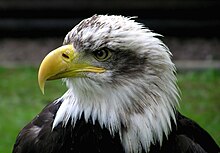
Eagles, Old World vultures, secretary-birds, hawks, harriers, etc.
- Family Accipitridae - buzzards, eagles, harriers, hawks, kites, Old World vultures
- Genus Accipiter
- Genus Aegypius
- Genus Aquila
- Genus Aviceda
- Genus Busarellus
- Genus Butastur
- Genus Buteo (probably paraphyletic, might include Leucopternis in part and Parabuteo)
- Genus Buteogallus (probably paraphyletic, might include Leucopternis in part)
- Genus Chelictinia
- Genus Chondrohierax
- Genus Circaetus
- Genus Circus
- Genus Clanga
- Genus Cryptoleucopteryx – plumbeous hawk
- Genus Elanoides - swallow-tailed kite
- Genus Elanus
- Genus Erythrotriorchis
- Genus Eutriorchis - Madagascan serpent eagle
- Genus Gampsonyx - pearl kite
- Genus Geranoaetus
- Genus Geranospiza - crane hawk
- Genus Gypaetus - bearded vulture
- Genus Gypohierax - palm-nut vulture
- Genus Gyps
- Genus Haliaeetus - sea eagles
- Genus Haliastur
- Genus Hamirostra - black-breasted buzzard
- Genus Harpagus
- Genus Harpia - harpy eagle
- Genus Harpyhaliaetus
- Genus Harpyopsis - Papuan eagle
- Genus Helicolestes – slender-billed kite, formerly included in Rostrhamus
- Genus Henicopernis
- Genus Hieraaetus
- Genus Ictinaetus - black eagle
- Genus Ictinia
- Genus Kaupifalco - lizard buzzard
- Genus Leptodon
- Genus Leucopternis (probably polyphyletic)
- Genus Lophaetus - long-crested eagle (possibly junior synonym of Ictinaetus)
- Genus Lophoictinia - square-tailed kite
- Genus Lophotriorchis - rufous-bellied eagle
- Genus Macheiramphus - bat hawk (was doubtfully placed, moved from Perninae)
- Genus Megatriorchis - Doria's goshawk
- Genus Melierax
- Genus Micronisus - Gabar goshawk
- Genus Milvus
- Genus Morphnarchus – barred hawk
- Genus Morphnus - crested eagle
- Genus Necrosyrtes - hooded vulture
- Genus Neophron - Egyptian vulture
- Genus Nisaetus
- Genus Parabuteo
- Genus Pernis
- Genus Pithecophaga
- Genus Polemaetus
- Genus Polyboroides
- Genus Pseudastur
- Genus Rostrhamus - snail kite
- Genus Rupornis – roadside hawk
- Genus Sarcogyps - red-headed vulture
- Genus Spilornis
- Genus Spizaetus
- Genus Stephanoaetus
- Genus Terathopius - bateleur
- Genus Torgos - lappet-faced vulture
- Genus Trigonoceps - white-headed vulture
- Genus Urotriorchis - long-tailed hawk
- Family Cathartidae - New World vultures
- Genus Cathartes
- Genus Coragyps - black vulture
- Genus Gymnogyps
- Genus Sarcoramphus - king vulture
- Genus Vultur - Andean condor
- Family Pandionidae - osprey
- Genus Pandion
- Family Sagittariidae - secretarybird
- Genus Sagittarius

Waterfowl
- Family Anhimidae - screamers
- Family Anatidae
- Genus Aix - Mandarin duck and wood duck – dabbling ducks or Tadorninae?
- Genus Alopochen - Egyptian goose and Mascarene shelducks
- Genus Amazonetta - Brazilian teal
- Genus Anas - pintails, mallards, etc.
- Genus Anser - grey geese and white geese
- Genus Aythya - pochards, scaups, etc.
- Genus Biziura - musk ducks
- Genus Branta - black geese
- Genus Bucephala - goldeneyes
- Genus Cairina - Muscovy duck and white-winged duck (traditionally dabbling ducks, but may be paraphyletic)
- Genus Callonetta - ringed teal (dabbling ducks or Tadorninae?)
- Genus Cereopsis - Cape Barren goose (Anserinae, Tadorninae, or own subfamily?)
- Genus Chenonetta - maned duck (dabbling ducks or Tadorninae? Includes Euryanas.)
- Genus Chloephaga - sheldgoose
- Genus Clangula - long-tailed duck
- Genus Coscoroba - coscoroba swan (Anserinae or same subfamily as Cereopsis?)
- Genus Cyanochen - blue-winged goose (Tadorninae or more distant clade?)
- Genus Cygnus - true swans
- Genus Dendrocygna - whistling ducks
- Genus Heteronetta - black-headed duck
- Genus Histrionicus - harlequin duck (includes Ocyplonessa)
- Genus Hymenolaimus - blue duck
- Genus Lophodytes - hooded merganser
- Genus Lophonetta - crested duck
- Genus Malacorhynchus - pink-eared ducks (Tadorninae, Oxyurinae or Dendrocheninae?)
- Genus Mareca - wigeons and gadwalls
- Genus Marmaronetta - marbled duck
- Genus Melanitta - scoters
- Genus Merganetta - torrent duck
- Genus Mergellus - smew
- Genus Mergus - mergansers
- Genus Neochen
- Genus Netta - red-crested pochard and allies
- Genus Nettapus - pygmy geese
- Genus Nomonyx - masked duck
- Genus Oxyura - stiff-tailed ducks
- Genus Plectropterus - spur-winged goose
- Genus Polysticta - Steller's eider
- Genus Pteronetta - Hartlaub's duck
- Genus Radjah - Radjah shelduck
- Genus Salvadorina - Salvadori's teal
- Genus Sarkidiornis - comb duck (Tadorninae or closer to dabbling ducks?)
- Genus Sibirionetta - Baikal teal
- Genus Somateria - eiders
- Genus Spatula - shovelers
- Genus Speculanas - bronze-winged duck
- Genus Stictonetta - freckled duck
- Genus Tachyeres - steamer ducks (Tadorninae or closer to dabbling ducks?)
- Genus Tadorna - shelducks (possibly paraphyletic)
- Genus Thalassornis - white-backed duck
- Family Anseranatidae
- Genus Anseranas

Swifts, treeswifts and hummingbirds
- Family Apodidae - swifts
- Genus Aerodramus sometimes included in Collocalia
- Genus Aeronautes
- Genus Apus
- Genus Chaetura
- Genus Collocalia
- Genus Cypseloides
- Genus Cypsiurus
- Genus Hirundapus
- Genus Hydrochous - giant swiftlet
- Genus Mearnsia
- Genus Neafrapus
- Genus Panyptila
- Genus Rhaphidura
- Genus Schoutedenapus - African swiftlets
- Genus Streptoprocne
- Genus Tachornis
- Genus Tachymarptis
- Genus Telacanthura
- Genus Zoonavena
- Family Hemiprocnidae - treeswifts
- Genus Hemiprocne
- Family Trochilidae - hummingbirds
- Genus Abeillia – emerald-chinned hummingbird
- Genus Adelomyia – speckled hummingbird
- Genus Aglaeactis – sunbeams
- Genus Aglaiocercus – sylphs
- Genus Amazilia (includes Agyrtria)
- Genus Androdon – tooth-billed hummingbird
- Genus Anopetia – broad-tipped hermit
- Genus Anthocephala – blossomcrowns
- Genus Anthracothorax – mangos
- Genus Aphantochroa – sombre hummingbird
- Genus Archilochus
- Genus Atthis
- Genus Augastes – visorbearers
- Genus Avocettula – fiery-tailed awlbill
- Genus Basilinna (recently split from Hylocharis)
- Genus Boissonneaua – coronets
- Genus Calliphlox – Calliphlox woodstars
- Genus Calothorax – Calothorax sheartails
- Genus Calypte
- Genus Campylopterus – sabrewings
- Genus Chaetocercus – Chaetocercus woodstars
- Genus Chalcostigma – Chalcostigma thornbills
- Genus Chalybura – plumeleteers
- Genus Chlorestes – blue-chinned sapphire
- Genus Chlorostilbon – typical emeralds
- Genus Chrysolampis – ruby-topaz hummingbird
- Genus Chrysuronia – golden-tailed sapphire
- Genus Clytolaema – Brazilian ruby
- Genus Coeligena – Incas and starfrontlets
- Genus Colibri – violet-ears
- Genus Cyanophaia - blue-headed hummingbird
- Genus Cynanthus
- Genus Damophila – violet-bellied hummingbird
- Genus Discosura – thorntails
- Genus Doricha – typical sheartails
- Genus Doryfera – lancebills
- Genus Elvira – elvira emeralds
- Genus Ensifera – sword-billed hummingbird
- Genus Eriocnemis – typical pufflegs
- Genus Eugenes
- Genus Eulampis – caribs
- Genus Eulidia – Chilean woodstar
- Genus Eupetomena – swallow-tailed hummingbird
- Genus Eupherusa
- Genus Eutoxeres – sicklebills
- Genus Florisuga – jacobins
- Genus Glaucis
- Genus Goethalsia – pirre hummingbird
- Genus Goldmania – violet-capped hummingbird
- Genus Haplophaedia – Haplophaedia pufflegs
- Genus Heliactin – horned sungem
- Genus Heliangelus – sunangels
- Genus Heliodoxa – brilliants
- Genus Heliomaster – starthroats
- Genus Heliothryx – fairies
- Genus Hylocharis – typical sapphires
- Genus Hylonympha – scissor-tailed hummingbird
- Genus Klais – violet-headed hummingbird
- Genus Lafresnaya – mountain velvetbreast
- Genus Lampornis – typical mountaingems
- Genus Lamprolaima – garnet-throated hummingbird
- Genus Lepidopyga
- Genus Lesbia – trainbearers
- Genus Leucippus
- Genus Leucochloris – white-throated hummingbird
- Genus Loddigesia – marvelous spatuletail
- Genus Lophornis – coquettes
- Genus Mellisuga
- Genus Metallura – metaltails
- Genus Microchera – snowcap
- Genus Microstilbon – slender-tailed woodstar
- Genus Myrmia – short-tailed woodstar
- Genus Myrtis – purple-collared woodstar
- Genus Ocreatus – booted racket-tails
- Genus Opisthoprora – mountain avocetbill
- Genus Oreonympha – bearded mountaineer
- Genus Oreotrochilus – hillstars
- Genus Orthorhyncus – Antillean crested hummingbird
- Genus Oxypogon – bearded helmetcrests
- Genus Panterpe – fiery-throated hummingbird
- Genus Patagona – giant hummingbird
- Genus Phaeochroa – scaly-breasted hummingbird
- Genus Phaethornis – typical hermits
- Genus Phlogophilus – piedtails
- Genus Polyonymus – bronze-tailed comet
- Genus Polytmus – goldenthroats
- Genus Pterophanes – great sapphirewing
- Genus Ramphodon – saw-billed hermit
- Genus Ramphomicron – typical thornbills
- Genus Rhodopis – oasis hummingbird
- Genus Sappho – red-tailed comet
- Genus Schistes - wedgebills (sometimes included in Augastes)
- Genus Selasphorus
- Genus Sephanoides – firecrowns
- Genus Stephanoxis – plovercrests
- Genus Sternoclyta – violet-chested hummingbird
- Genus Taphrolesbia – grey-bellied comet
- Genus Taphrospilus - many-spotted hummingbird
- Genus Thalurania – woodnymphs
- Genus Thaumastura – Peruvian sheartail
- Genus Threnetes – barbthroats
- Genus Tilmatura – sparkling-tailed woodstar
- Genus Topaza – topazes
- Genus Trochilus – streamertails
- Genus Urochroa – white-tailed hillstar
- Genus Urosticte – whitetips
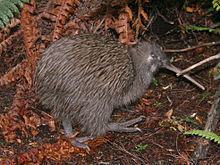
- Family Apterygidae
- Genus Apteryx - kiwi
Hornbills, hoopoes, and wood-hoopoes
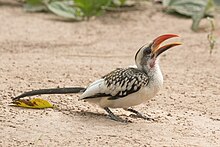
- Family Bucerotidae
- Genus Aceros - rufous-necked hornbill
- Genus Anorrhinus - brown hornbill
- Genus Anthracoceros - pied hornbill
- Genus Berenicornis - white-crowned hornbill (sometimes included in Aceros)
- Genus Buceros
- Genus Bycanistes
- Genus Ceratogymna - casqued hornbill
- Genus Lophoceros
- Genus Ocyceros - grey hornbill
- Genus Penelopides
- Genus Rhinoplax - helmeted hornbill (sometimes included in Buceros)
- Genus Rhyticeros (sometimes included in Aceros)
- Genus Tockus
- Genus Tropicranus - white-crested hornbill (sometimes included in Tockus)
- Family Bucorvidae
- Genus Bucorvus - ground hornbills
- Family Phoeniculidae
- Genus Phoeniculus - wood hoopoes
- Genus Rhinopomastus - scimitarbills
- Family Upupidae
- Genus Upupa - hoopoes
Nightjars, nighthawks, potoos, oilbirds, frogmouths and owlet-nightjars

- Family Aegothelidae - owlet-nightjars
- Genus Aegotheles
- Family Caprimulgidae - nightjars
- Genus Antrostomus
- Genus Caprimulgus
- Genus Chordeiles
- Genus Eleothreptus
- Genus Eurostopodus
- Genus Gactornis – collared nightjar
- Genus Hydropsalis
- Genus Lurocalis
- Genus Lyncornis
- Genus Macropsalis – long-trained nightjar
- Genus Nyctidromus
- Genus Nyctiphrynus
- Genus Nyctipolus
- Genus Nyctiprogne
- Genus Phalaenoptilus – common poorwill
- Genus Setopagis
- Genus Siphonorhis
- Genus Systellura
- Genus Uropsalis
- Family Nyctibiidae - potoos
- Genus Nyctibius
- Family Podargidae - frogmouths
- Genus Batrachostomus
- Genus Podargus
- Genus Rigidipenna - Solomons frogmouth
- Family Steatornithidae - oilbird
- Genus Steatornis

- Family Cariamidae - seriemas
Cassowaries and emus

- Family Casuariidae
New World vultures

- Family Cathartidae
- Genus Cathartes
- Genus Coragyps - black vulture
- Genus Gymnogyps
- Genus Sarcoramphus - king vulture
- Genus Vultur - Andean condor
Plovers, crab plovers, lapwings, seagulls, puffins, auks, sandpipers, buttonquails, stilts, avocets, ibisbills, woodcocks, skuas, etc.

- Family Alcidae - puffins, guillemots, murres, and allies
- Genus Aethia - auklets
- Genus Alca - razorbill
- Genus Alle - little auk
- Genus Brachyramphus - murrelets
- Genus Cepphus - guillemots
- Genus Cerorhinca - rhinoceros auklet
- Genus Fratercula - puffins
- Genus Ptychoramphus - Cassin's auklet
- Genus Synthliboramphus - murrelets
- Genus Uria - murres
- Family Burhinidae - thick-knees
- Family Charadriidae - plovers and lapwings
- Genus Anarhynchus - wrybill
- Genus Charadrius
- Genus Elseyornis - black-fronted dotterel
- Genus Erythrogonys - red-kneed dotterel
- Genus Oreopholus - tawny-throated dotterel
- Genus Peltohyas - inland dotterel
- Genus Phegornis - diademed sandpiper-plover
- Genus Pluvialis
- Genus Thinornis
- Genus Vanellus
- Family Chionididae - sheathbills
- Genus Chionis
- Family Dromadidae - crab plover
- Genus Dromas
- Family Glareolidae - pratincoles and coursers
- Genus Cursorius
- Genus Glareola
- Genus Rhinoptilus
- Genus Stiltia - Australian pratincole
- Family Haematopodidae - oystercatchers
- Genus Haematopus
- Family Ibidorhynchidae - ibisbill
- Genus Ibidorhyncha
- Family Jacanidae - jacanas
- Genus Actophilornis
- Genus Hydrophasianus - pheasant-tailed jacana
- Genus Irediparra - comb-crested jacana
- Genus Jacana
- Genus Metopidius - bronze-winged jacana
- Genus Microparra - lesser jacana
- Family Laridae - gulls, terns, and skimmers
- Genus Anous
- Genus Chlidonias - marsh tern
- Genus Chroicocephalus
- Genus Creagrus - swallow-tailed gull
- Genus Gelochelidon - gull-billed tern
- Genus Gygis - white tern
- Genus Hydrocoloeus - little gull
- Genus Hydroprogne - Caspian tern
- Genus Ichthyaetus
- Genus Larosterna - Inca tern
- Genus Larus
- Genus Leucophaeus
- Genus Onychoprion
- Genus Pagophila - ivory gull
- Genus Phaetusa - large-billed tern
- Genus Rhodostethia - Ross's gull
- Genus Rissa - kittiwakes
- Genus Rynchops - skimmers
- Genus Sterna
- Genus Sternula
- Genus Thalasseus
- Genus Xema - Sabine's gull
- Family Pedionomidae - plains wanderer
- Genus Pedionomus
- Family Pluvianellidae - Magellanic plover
- Genus Pluvianellus
- Family Pluvianidae - Egyptian plover
- Genus Pluvianus
- Family Recurvirostridae - avocets and stilts
- Genus Cladorhynchus - banded stilt
- Genus Himantopus - stilts
- Genus Recurvirostra - avocets
- Family Rostratulidae - painted snipes
- Genus Nycticryphes
- Genus Rostratula
- Family Scolopacidae - snipe, sandpipers, phalaropes, and allies
- Genus Actitis
- Genus Arenaria - turnstones
- Genus Bartramia - upland sandpiper
- Genus Calidris - sandpipers
- Genus Coenocorypha - Austral snipes
- Genus Gallinago
- Genus Limnodromus - dowitchers
- Genus Limosa - godwits
- Genus Lymnocryptes - jack snipe
- Genus Numenius - curlews
- Genus Phalaropus - phalaropes
- Genus Prosobonia - Polynesian sandpiper
- Genus Scolopax
- Genus Tringa
- Genus Xenus - Terek sandpiper
- Family Stercorariidae - skuas
- Genus Stercorarius
- Family Thinocoridae - seedsnipes
- Genus Attagis
- Genus Thinocorus
- Family Turnicidae - buttonquails
Storks, openbills, and jabiru
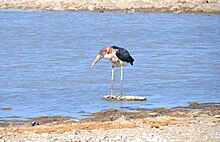
- Family Ciconiidae
- Genus Anastomus - openbills
- Genus Ciconia
- Genus Ephippiorhynchus
- Genus Jabiru
- Genus Leptoptilos
- Genus Mycteria
Mousebirds
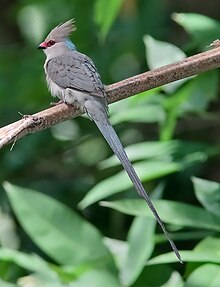
Pigeons and doves

- Family Columbidae
- Genus Alectroenas - blue pigeons
- Genus Alopecoenas
- Genus Caloenas - Nicobar pigeon
- Genus Chalcophaps - emerald doves
- Genus Claravis
- Genus Columba includes Aplopelia, Old World pigeons
- Genus Columbina
- Genus Cryptophaps - sombre pigeon
- Genus Didunculus - tooth-billed pigeon
- Genus Drepanoptila - possibly better merged with Ptilinopus
- Genus Ducula - imperial pigeons
- Genus Dysmoropelia - Saint Helena dove
- Genus Gallicolumba
- Genus Geopelia
- Genus Geophaps
- Genus Geotrygon - quail-doves
- Genus Goura
- Genus Gymnophaps - mountain pigeons
- Genus Hemiphaga
- Genus Henicophaps
- Genus Leptotila
- Genus Leptotrygon - olive-backed quail-dove
- Genus Leucosarcia - wonga pigeon
- Genus Lopholaimus - topknot pigeon
- Genus Macropygia
- Genus Metriopelia
- Genus Nesoenas
- Genus Ocyphaps - crested pigeon
- Genus Oena - Namaqua dove, tentatively placed here
- Genus Otidiphaps - pheasant pigeon
- Genus Patagioenas - American pigeons
- Genus Petrophassa - rock pigeons
- Genus Phapitreron - brown dove
- Genus Phaps
- Genus Ptilinopus
- Genus Reinwardtoena
- Genus Starnoenas - blue-headed quail-dove
- Genus Spilopelia
- Genus Streptopelia - turtledoves
- Genus Treron - green pigeons
- Genus Trugon - thick-billed ground pigeon
- Genus Turacoena
- Genus Turtur - African wood doves, tentatively placed here
- Genus Uropelia - long-tailed ground dove
- Genus Zenaida - Zenaida doves
- Genus Zentrygon
Rollers, bee eaters, todies, kingfishers, etc.

- Family Alcedinidae - kingfishers
- Genus Actenoides
- Genus Alcedo
- Genus Caridonax - glittering kingfisher
- Genus Ceryle - pied kingfisher
- Genus Ceyx
- Genus Chloroceryle - American green kingfisher
- Genus Cittura - lilac kingfisher
- Genus Clytoceyx
- Genus Corythornis
- Genus Dacelo
- Genus Halcyon
- Genus Ispidina
- Genus Lacedo
- Genus Megaceryle
- Genus Melidora - hook-billed kingfisher
- Genus Pelargopsis
- Genus Syma
- Genus Tanysiptera - paradise kingfisher
- Genus Todirhamphus
- Family Brachypteraciidae - ground rollers
- Genus Atelornis
- Genus Brachypteracias - short-legged ground roller
- Genus Geobiastes - scaly ground roller
- Genus Uratelornis - long-tailed ground roller
- Family Coraciidae - rollers
- Genus Coracias
- Genus Eurystomus
- Family Meropidae - bee-eaters
- Genus Meropogon - purple-bearded bee-eater
- Genus Merops
- Genus Nyctyornis
- Family Momotidae - motmots
- Family Todidae - todies
- Genus Todus
Cuckoos, anis, etc.

- Family Cuculidae
- Genus Cacomantis
- Genus Carpococcyx – Asian ground-cuckoos
- Genus Centropus - coucals
- Genus Cercococcyx – long-tailed cuckoos
- Genus Ceuthmochares – yellowbills
- Genus Chrysococcyx – bronze cuckoos
- Genus Clamator
- Genus Coccycua – formerly in Coccyzus and Piaya, includes Micrococcyx
- Genus Coccyzus – includes Saurothera and Hyetornis
- Genus Coua – coua
- Genus Crotophaga – anis
- Genus Cuculus – typical cuckoos
- Genus Dromococcyx
- Genus Eudynamys – typical koels
- Genus Geococcyx – roadrunners
- Genus Guira – guira cuckoo
- Genus Hierococcyx – hawk-cuckoos
- Genus Microdynamis – dwarf koel
- Genus Morococcyx – lesser ground cuckoo
- Genus Neomorphus – Neotropical ground-cuckoos
- Genus Pachycoccyx – thick-billed cuckoo
- Genus Phaenicophaeus – typical malkohas
- Genus Piaya
- Genus Rhinortha – Raffles's malkoha (sometimes in Phaenicophaeus; tentatively placed here)
- Genus Scythrops – channel-billed cuckoo
- Genus Surniculus – drongo-cuckoos
- Genus Tapera – striped cuckoo
- Genus Urodynamis – Pacific long-tailed cuckoo
Sunbitterns and kagu

- Family Eurypygidae - sunbittern
- Genus Eurypyga
- Family Rhynochetidae - kagu
- Genus Rhynochetos
Falcons and caracara
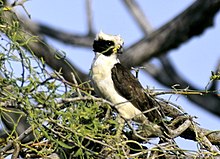
- Family Falconidae
- Genus Caracara – crested caracaras
- Genus Daptrius – black caracara
- Genus Falco – true falcons, hobbies and kestrels
- Genus Herpetotheres – laughing falcon
- Genus Ibycter – red-throated caracara (sometimes included in Daptrius)
- Genus Micrastur – forest falcons
- Genus Microhierax – typical falconets
- Genus Milvago – brown caracaras
- Genus Phalcoboenus – Andean and southern South American caracaras
- Genus Polihierax – pygmy falcons
- Genus Spiziapteryx – spot-winged falconet
Gamebirds
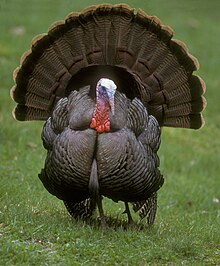
- Family Cracidae
- Genus Aburria
- Genus Chamaepetes
- Genus Crax - curassows
- Genus Mitu - curassows
- Genus Nothocrax - nocturnal curassow
- Genus Oreophasis - horned guan
- Genus Ortalis - chachalacas
- Genus Papile - Piping guan
- Genus Pauxi - helmeted curassows
- Genus Penelope
- Genus Penelopina
- Family Megapodiidae
- Genus Aepypodius
- Genus Alectura - Australian brushturkey
- Genus Eulipoa - Moluccan megapode
- Genus Leipoa
- Genus Macrocephalon - maleo
- Genus Megapodius - scrubfowl
- Genus Talegalla
- Family Numididae
- Family Odontophoridae
- Genus Callipepla
- Genus Colinus
- Genus Cyrtonyx
- Genus Dactylortyx - singing quail
- Genus Dendrortyx
- Genus Odontophorus - wood quails
- Genus Oreortyx - mountain quails
- Genus Philortyx - banded quail
- Genus Ptilopachus
- Genus Rhynchortyx - tawny-faced quail
- Family Phasianidae
- Genus Afropavo' - Congo peafowl
- Genus Alectoris - rock partridges
- Genus Ammoperdix - see-see and sand partridge
- Genus Anurophasis - Snow Mountain quail
- Genus Arborophila - hill partridge
- Genus Argusianus - great argus
- Genus Bambusicola - bamboo partridge
- Genus Bonasa - ruffed grouse
- Genus Caloperdix - ferruginous partridge
- Genus Catreus - cheer pheasant
- Genus Centrocercus - sage grouse
- Genus Chrysolophus - ruffed pheasant
- Genus Coturnix - mouse pheasant
- Genus Crossoptilon - eared pheasant
- Genus Dendragapus
- Genus Excalfactoria
- Genus Falcipennis
- Genus Francolinus - true francolins
- Genus Galloperdix - Indian spurfowl
- Genus Gallus - junglefowl
- Genus Haematortyx - crimson-headed partridge
- Genus Ithaginis - blood pheasant
- Genus Lagopus - ptarmigans
- Genus Lerwa - snow partridge
- Genus Lophophorus - monal
- Genus Lophura - gallopheasants
- Genus Margaroperdix - Madagascan partridge
- Genus Melanoperdix - black partridge
- Genus Meleagris - turkeys
- Genus Ophrysia - Himalayan quail
- Genus Pavo - peafowl
- Genus Peliperdix
- Genus Perdicula - bush quail
- Genus Perdix - true partridges
- Genus Phasianus - typical pheasants
- Genus Polyplectron - peacock-pheasant
- Genus Pternistis - African spurfowls
- Genus Pucrasia - Koklass pheasant
- Genus Rheinardia - crested argus
- Genus Rhizothera
- Genus Rollulus - crested partridge
- Genus Scleroptila
- Genus Synoicus - see Coturnix
- Genus Syrmaticus - long-tailed pheasants
- Genus Tetrao - capercaillies and black grouse
- Genus Tetraogallus - snowcocks
- Genus Tetraophasis - monal-partridge
- Genus Tetrastes
- Genus Tragopan - horned pheasant
- Genus Tympanuchus - prairie chickens
- Genus Xenoperdix - forest partridges

Cranes, crakes, rails, wood-rails, fluftais, gallinules, limpkin, trumpeters, and finfoots

- Family Aramidae - limpkin
- Genus Aramus
- Family Gruidae - cranes
- Genus Antigone
- Genus Balearica
- Genus Grus - cranes
- Genus Leucogeranus - Siberian crane
- Family Heliornithidae - finfoots
- Family Psophiidae
- Genus Psophia - trumpeters
- Family Rallidae - crakes, moorhens, gallinules, and rails
- Genus Aenigmatolimnas - striped crake
- Genus Amaurolimnas - uniform crake
- Genus Amaurornis - bush-hens
- Genus Anurolimnas
- Genus Aramides
- Genus Aramidopsis – snoring rail
- Genus Atlantisia - Inaccessible Island rail
- ?Genus Biensis - Madagascan rails (synonym of Rallus?)
- Genus Cabalus - Chatham rail
- Genus Coturnicops - barred-backed crake
- ?Genus Creciscus - blackish crake
- Genus Crecopsis – African crake
- Genus Crex - corn crake
- Genus Cyanolimnas – Zapata rail
- Genus Diaphorapteryx - Hawkins's rail
- Genus Dryolimnas
- Genus Eulabeornis – chestnut rail
- Genus Fulica - coots
- Genus Gallicrex - watercock
- Genus Gallinula - moorhens
- Genus Gallirallus
- Genus Gymnocrex - bare-faced rails
- Genus Habroptila – invisible rail
- Genus Hapalocrex - yellow-breasted crake
- Genus Himantornis - Nkulengu rail
- Genus Laterallus - ruddy crake
- Genus Lewinia
- ?Genus Limnocrex (synonym of Laterallus?)
- Genus Megacrex - New Guinea flightless rail
- Genus Micropygia - ocellated crake
- Genus Mundia - Ascension crake
- Genus Mustelirallus
- Genus Nesoclopeus
- Genus Paragallinula - lesser moorhen
- Genus Pardirallus
- Genus Poliolimnas - see Amaurornis
- Genus Porphyrio - swamphens
- Genus Porphyriops – spot-flanked gallinule
- Genus Porzana
- Genus Rallicula - forest rails
- Genus Rallina - chestnut rails
- Genus Rallus
- Genus Rougetius - Rouget's rail
- Genus Rufirallus - russet-crowned crake
- Genus Tribonyx - native-hens
- Genus Zapornia - see Porzana
- Family Sarothruridae
- Genus Canirallus - grey-throated rail and wood rails
- Genus Sarothrura - flufftails

- Family Leptosomidae
- Genus Leptosomus - cuckoo roller
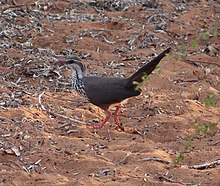
- Family Mesitornithidae - mesites
- Genus Mesitornis
- Genus Monias - Subdesert mesite
Turacos and go-away-birds

Corythaeola cristata
- Family Musophagidae
- Genus Corythaeola - great blue turaco
- Genus Corythaixoides - go-away-birds
- Genus Crinifer - plantain-eaters
- Genus Musophaga
- Genus Ruwenzorornis - Rwenzori turaco
- Genus Tauraco

- Family Opisthocomidae
- Genus Opisthocomus - hoatzin
Bustards, floricans, etc.

- Family Otididae
- Genus Afrotis
- Genus Ardeotis
- Genus Chlamydotis
- Genus Eupodotis
- Genus Houbaropsis - Bengal florican
- Genus Lissotis
- Genus Lophotis
- Genus Neotis
- Genus Otis - great bustard
- Genus Sypheotides
- Genus Tetrax - little bustard
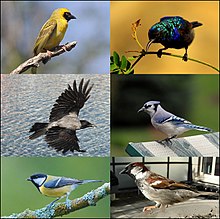
Passerines, the "song birds". This is the largest order of birds and contains more than half of all birds.
- Family Acanthisittidae
- Genus Acanthisitta - rifleman
- Genus Xenicus - New Zealand wrens
- Family Acanthizidae - scrubwrens, thornbills, and gerygones
- Genus Acanthiza – thornbill
- Genus Acanthornis – scrubtit
- Genus Aethomyias – scrubwrens
- Genus Aphelocephala – whiteface
- Genus Calamanthus – fieldwren
- Genus Crateroscelis
- Genus Gerygone
- Genus Hylacola – heathwren
- Genus Neosericornis – yellow-throated scrubwren
- Genus Oreoscopus – fernwren
- Genus Origma
- Genus Pachycare – goldenface
- Genus Pycnoptilus – pilotbird
- Genus Pyrrholaemus - speckled warbler
- Genus Sericornis – scrubwrens
- Genus Smicrornis – weebill
- Family Acrocephalidae - marsh- and tree-warblers, recently split from the Sylviidae
- Genus Acrocephalus
- Genus Calamonastides - papyrus yellow warbler
- Genus Chloropeta
- Genus Hippolais
- Genus Iduna
- Genus Nesillas
- Family Aegithalidae - long-tailed tits or bushtits
- Genus Aegithalos
- Genus Leptopoecile
- Genus Psaltriparus - American bushtit
- Family Aegithinidae
- Genus Aegithina - iora
- Family Alaudidae - larks
- Genus Alaemon – hoopoe-lark
- Genus Alauda – skylark
- Genus Alaudala
- Genus Ammomanes
- Genus Ammomanopsis – Gray's lark
- Genus Calandrella – short-toed lark
- Genus Calendulauda
- Genus Certhilauda – short-clawed lark and long-billed lark
- Genus Chersomanes – spike-heeled lark
- Genus Chersophilus – Dupont's lark
- Genus Eremalauda – Dunn's lark
- Genus Eremophila – horned lark
- Genus Eremopterix – sparrow-larks
- Genus Galerida – Large-billed lark and crested lark
- Genus Heteromirafra – Rudd's lark and Archer's lark
- Genus Lullula – woodlark
- Genus Melanocorypha
- Genus Mirafra – larks and bushlarks
- Genus Pinarocorys – dusky lark and rufous-rumped lark
- Genus Ramphocoris – thick-billed lark
- Genus Spizocorys
- Family Artamidae - woodswallows, butcherbirds, currawongs, and Australian magpie
- Family Atrichornithidae
- Genus Atrichornis - scrub-birds
- Family Bernieridae - Malagasy warblers, a newly assembled family
- Genus Bernieria – Madagascan warbler
- Genus Crossleyia – Madagascan yellowbrow
- Genus Cryptosylvicola – cryptic warbler
- Genus Hartertula – wedge-tailed jery
- Genus Oxylabes – white-throated oxylabes
- Genus Randia – Rand's warbler
- Genus Thamnornis – Thamnornis
- Genus Xanthomixis
- Family Bombycillidae
- Genus Bombycilla - waxwings
- Family Buphagidae
- Genus Buphagus - oxpeckers. Formerly usually included in Sturnidae.
- Family Calcariidae - longspurs and snow buntings
- Genus Calcarius - longspurs
- Genus Plectrophenax - snow and McKay's buntings
- Genus Rhynchophanes - thick-billed longspur
- Family Callaeidae - New Zealand wattlebirds
- Genus Callaeas - kokako
- Genus Heteralocha - huia
- Genus Philesturnus - saddleback
- Family Calyptophilidae
- Genus Calyptophilus - chat-tanagers
- Family Campephagidae - cuckooshrikes and trillers
- Genus Campephaga
- Genus Campochaera - golden cuckooshrike
- Genus Ceblepyris
- Genus Celebesica - pygmy cuckooshrike
- Genus Coracina
- Genus Cyanograucalus - blue cuckooshrike
- Genus Edolisoma
- Genus Lalage
- Genus Lobotos
- Genus Malindangia - McGregor's cuckooshrike
- Genus Pericrocotus - minivet
- Family Cardinalidae - cardinals and allies
- Genus Amaurospiza
- Genus Cardinalis
- Genus Caryothraustes
- Genus Chlorothraupis
- Genus Cyanocompsa
- Genus Cyanoloxia - Glaucous-blue grosbeak
- Genus Granatellus
- Genus Habia
- Genus Passerina
- Genus Periporphyrus - red-and-black grosbeak
- Genus Pheucticus
- Genus Piranga
- Genus Rhodothraupis - crimson-collared grosbeak
- Genus Spiza - dickcissel
- Family Certhiidae - treecreepers
- Family Cettiidae - ground-warblers and allies, recently split from the Sylviidae
- Genus Abroscopus – abroscopus warbler
- Genus Cettia – typical bush warblers
- Genus Horornis
- Genus Hylia – green hylia (tentatively placed here)
- Genus Pholidornis – tit hylia (formerly in Remizidae; tentatively placed here)
- Genus Phyllergates
- Genus Tesia
- Genus Tickellia – broad-billed warbler
- Genus Urosphena – stubtails
- Family Chaetopidae
- Genus Chaetops - rockjumpers, recently split from the Turdidae
- Family Chloropseidae
- Genus Chloropsis - leafbirds
- Family Cinclidae
- Genus Cinclus - dippers
- Family Cisticolidae - cisticolas and allies
- Genus Apalis
- Genus Artisornis
- Genus Bathmocercus - rufous warblers
- Genus Calamonastes
- Genus Camaroptera
- Genus Cisticola
- Genus Drymocichla - red-winged grey warbler
- Genus Eminia - grey-capped warbler
- Genus Eremomela
- Genus Euryptila - cinnamon-breasted warbler
- Genus Heliolais – red-winged warbler (Sometimes placed in Prinia)
- Genus Hypergerus - oriole warbler
- Genus Incana - Socotra warbler
- Genus Malcorus - rufous-eared warbler
- Genus Micromacronus
- Genus Neomixis - Jerys (genus is basal to all other Cisticolidae)
- Genus Oreolais (moved here from Apalis)
- Genus Oreophilais - Roberts's warbler
- Genus Orthotomus - tailorbirds
- Genus Phragmacia - Namaqua warbler
- Genus Phyllolais - buff-bellied warbler
- Genus Poliolais - white-tailed warbler
- Genus Prinia
- Genus Scepomycter (sometimes merged into Bathmocercus)
- Genus Schistolais
- Genus Spiloptila - cricket warbler
- Genus Urolais - green longtail
- Genus Urorhipis– sometimes placed in Prinia
- Family Climacteridae - Australian treecreeper
- Genus Cormobates
- Genus Climacteris
- Family Cnemophilidae - satinbirds
- Genus Cnemophilus
- Genus Loboparadisea - yellow-breasted satinbird
- Family Conopophagidae - gnateaters and gnatpittas
- Genus Conopophaga
- Genus Pittasoma
- Family Corcoracidae - Australian mudnester
- Genus Corcorax - white-winged chough
- Genus Struthidea - apostlebird
- Family Corvidae - crows, ravens, and jays
- Genus Aphelocoma – scrub jays
- Genus Calocitta – Magpie-jay
- Genus Cissa - magpies
- Genus Corvus - crows and ravens
- Genus Crypsirina - treepies
- Genus Cyanocitta - jays
- Genus Cyanocorax - jays
- Genus Cyanolyca
- Genus Cyanopica - magpies
- Genus Dendrocitta - treepies
- Genus Garrulus - jays
- Genus Gymnorhinus - pinyon jay
- Genus Nucifraga - nutcrackers
- Genus Perisoreus - jays
- Genus Pica - magpies
- Genus Platylophu - Crested jay
- Genus Platysmurus - black magpie
- Genus Podoces – ground jays
- Genus Psilorhinus - brown jay
- Genus Ptilostomus - piapiac
- Genus Pyrrhocorax - chough
- Genus Temnurus - ratchet-tailed treepie
- Genus Urocissa - blue magpies
- Genus Zavattariornis - Stresemann's bushcrow
- Family Cotingidae - cotingas and allies
- Genus Ampelioides - scaled fruiteater
- Genus Ampelion
- Genus Carpodectes
- Genus Carpornis - berryeaters
- Genus Cephalopterus - umbrellabirds
- Genus Conioptilon - black-faced cotinga
- Genus Cotinga
- Genus Doliornis
- Genus Gymnoderus - bare-necked fruitcrow
- Genus Haematoderus - crimson fruitcrow
- Genus Lipaugus
- Genus Perissocephalus - capuchinbird
- Genus Phibalura - swallow-tailed cotinga
- Genus Phoenicircus
- Genus Phytotoma - plantcutters
- Genus Pipreola
- Genus Porphyrolaema - purple-throated cotinga
- Genus Procnias - Neotropical bellbird
- Genus Pyroderus - red-ruffed fruitcrow
- Genus Querula - purple-throated fruitcrow
- Genus Rupicola
- Genus Snowornis
- Genus Tijuca
- Genus Xipholena
- Genus Zaratornis - white-cheeked cotinga
- Family Dasyornithidae
- Genus Dasyornis - bristlebirds (formerly in Acanthizidae)
- Family Dicaeidae - flowerpeckers (sunbirds and flowerpeckers, might be included in Passeroidea)
- Genus Dicaeum
- Genus Prionochilus
- Family Dicruridae
- Genus Dicrurus - drongos
- Family Donacobiidae
- Genus Donacobius - black-capped donacobius (previously classed as a wren, but probably closest to the Locustellidae or Bernieridae)
- Family Dulidae (tentatively placed here)
- Genus Dulus- palmchat
- Family Elachuridae
- Genus Elachura - spotted elachura
- Family Emberizidae
- Genus Diglossopis
- Genus Emberiza - Old World buntings
- Family Erythrocercidae
- Genus Erythrocercus
- Family Estrildidae - estrildid finches (waxbills, munias, and allies)
- Genus Amadina - cut-throats
- Genus Amandava - avadavats
- Genus Clytospiza - brown twinspot
- Genus Coccopygia
- Genus Cryptospiza - crimsonwings
- Genus Emblema - painted finch
- Genus Erythrura - parrotfinches (includes Chloebia)
- Genus Estrilda - waxbills
- Genus Euodice - silverbill
- Genus Euschistospiza
- Genus Heteromunia - pictorella mannikin
- Genus Hypargos
- Genus Lagonosticta - firefinches
- Genus Lonchura - Munias, mannikins, and silverbills
- Genus Mandingoa - green-backed twinspot
- Genus Neochmia
- Genus Nesocharis - oliveback
- Genus Nigrita
- Genus Odontospiza - grey-headed silverbill
- Genus Oreostruthus - mountain firetail
- Genus Ortygospiza - quailfinches
- Genus Padda
- Genus Paludipasser - locust finch
- Genus Parmoptila - antpeckers
- Genus Poephila
- Genus Pyrenestes - seedcrackers
- Genus Pytilia
- Genus Spermophaga - bluebill
- Genus Stagonopleura - firetail
- Genus Taeniopygia
- Genus Uraeginthus
- Family Eulacestomidae
- Genus Eulacestoma - wattled ploughbill
- Family Eupetidae
- Genus Eupetes - Malaysian rail-babbler (recently split from the Cinclosomatidae)
- Family Eurylaimidae - broadbills
- Genus Calyptomena
- Genus Corydon - dusky broadbill
- Genus Cymbirhynchus - black-and-red broadbill
- Genus Eurylaimus
- Genus Neodrepanis
- Genus Philepitta
- Genus Psarisomus - long-tailed broadbill
- Genus Pseudocalyptomena - Grauer's broadbill
- Genus Sarcophanops
- Genus Serilophus - silver-breasted broadbill
- Genus Smithornis
- Family Formicariidae - Antthrushe
- Genus Chamaeza
- Genus Formicarius
- Family Fringillidae - true finches and Hawaiian honeycreepers. (Possibly polyphyletic)
- Genus Acanthis – redpolls
- Genus Agraphospiza – Blanford's rosefinch
- Genus Bucanetes – trumpeter finch and Mongolian finch
- Genus Callacanthis – spectacled finch
- Genus Carduelis
- Genus Carpodacus – rosefinches
- Genus Chloridops
- Genus Chloris – greenfinches
- Genus Chlorodrepanis - 'amakihis
- Genus Chlorophonia
- Genus Chrysocorythus – mountain serin
- Genus Coccothraustes
- Genus Crithagra
- Genus Drepanis
- Genus Eophona – Chinese grosbeak and Japanese grosbeak
- Genus Euphonia
- Genus Fringilla
- Genus Haemorhous – American rosefinches
- Genus Hemignathus
- Genus Himatione
- Genus Leucosticte – mountain and rosy finches
- Genus Linaria
- Genus Linurgus – oriole finch
- Genus Loxia – crossbills
- Genus Loxioides – palila
- Genus Loxops
- Genus Magumma – ʻanianiau
- Genus Melamprosops – poʻouli
- Genus Mycerobas – Palearctic grosbeaks
- Genus Oreomystis – ʻakikiki
- Genus Palmeria – ʻakohekohe
- Genus Paroreomyza
- Genus Pinicola – pine grosbeak
- Genus Procarduelis – dark-breasted rosefinch
- Genus Pseudonestor – Maui parrotbill
- Genus Psittirostra – ʻŌʻū
- Genus Pyrrhoplectes – golden-naped finch
- Genus Pyrrhula – bullfinches
- Genus Rhodopechys
- Genus Rhodospiza – desert finch
- Genus Rhynchostruthus – golden-winged grosbeak
- Genus Serinus
- Genus Spinus
- Genus Telespiza
- Family Furnariidae - ovenbirds and woodcreepers
- Genus Acrobatornis – pink-legged graveteiro
- Genus Anabacerthia – foliage-gleaners
- Genus Anabazenops – foliage-gleaners
- Genus Ancistrops – chestnut-winged hookbill
- Genus Anumbius – firewood-gatherer
- Genus Aphrastura – rayaditos
- Genus Asthenes – canasteros
- Genus Automolus – foliage-gleaners
- Genus Berlepschia – point-tailed palmcreeper
- Genus Campylorhamphus – scythebills
- Genus Certhiasomus – spot-throated woodcreeper (also described as Deconychura stictolaema)
- Genus Certhiaxis – spinetails
- Genus Cichlocolaptes
- Genus Cinclodes
- Genus Clibanornis
- Genus Coryphistera – lark-like brushrunner
- Genus Cranioleuca – typical spinetails
- Genus Deconychura – long-tailed woodcreeper
- Genus Dendrexetastes – cinnamon-throated woodcreeper
- Genus Dendrocincla – woodcreepers
- Genus Dendrocolaptes – woodcreepers
- Genus Dendroplex – straight-billed woodcreeper (formerly in Xiphorhynchus)
- Genus Drymornis – scimitar-billed woodcreeper
- Genus Drymotoxeres – greater scythebill
- Genus Furnarius – horneros
- Genus Geocerthia – striated earthcreeper (also described as Upucerthia serrana)
- Genus Geositta – miners
- Genus Glyphorynchus – wedge-billed woodcreeper
- Genus Heliobletus – sharp-billed treehunter
- Genus Hellmayrea – white-browed spinetail
- Genus Hylexetastes – woodcreepers
- Genus Lepidocolaptes – narrow-billed woodcreeper
- Genus Leptasthenura – tit-spinetails
- Genus Limnoctites – straight-billed reedhaunter (sometimes included in Limnornis, but closer to, and possibly better merged with Cranioleuca)
- Genus Limnornis – curve-billed reedhaunter
- Genus Lochmias – sharp-tailed streamcreeper
- Genus Margarornis – treerunners
- Genus Mazaria – white-bellied spinetail
- Genus Megaxenops – great xenops
- Genus Metopothrix – orange-fronted plushcrown
- Genus Microxenops – rufous-tailed xenops
- Genus Nasica – long-billed woodcreeper
- Genus Ochetorhynchus – earthcreepers (formerly included in Upucerthia) (includes Chilia)
- Genus Phacellodomus – Thornbird
- Genus Philydor – foliage-gleaners
- Genus Phleocryptes – wren-like rushbird
- Genus Premnoplex – typical barbtails
- Genus Premnornis – rusty-winged barbtail
- Genus Pseudasthenes – "false" canasteros
- Genus Pseudocolaptes – tuftedcheeks
- Genus Pseudoseisura
- Genus Pygarrhichas – white-throated treerunner
- Genus Roraimia -
- Genus Schoeniophylax – Chotoy spinetail
- Genus Sclerurus – leaftossers
- Genus Siptornis – spectacled prickletail
- Genus Sittasomus – olivaceous woodcreeper
- Genus Spartonoica – bay-capped wren-spinetail
- Genus Sylviorthorhynchus – Des Murs's wiretail
- Genus Synallaxis – spinetails
- Genus Syndactyla – foliage-gleaners
- Genus Tarphonomus (new genus for 2 species formerly included in Upucerthia)
- Genus Thripadectes – treehunters
- Genus Thripophaga – softtails
- Genus Upucerthia – earthcreepers
- Genus Xenerpestes – greytails
- Genus Xenops
- Genus Xiphocolaptes – woodcreepers
- Genus Xiphorhynchus – woodcreepers (possibly polyphyletic)
- Family Grallariidae - antpittas
- Genus Grallaria
- Genus Grallaricula
- Genus Hylopezus
- Genus Myrmothera
- Family Hirundinidae - swallows and martins
- Genus Alopochelidon - tawny-headed swallow
- Genus Atticora
- Genus Cecropis
- Genus Cheramoeca - white-backed swallow
- Genus Delichon
- Genus Haplochelidon - Andean swallow
- Genus Hirundo
- Genus Neochelidon - white-thighed swallow
- Genus Notiochelidon
- Genus Petrochelidon
- Genus Phedina
- Genus Progne
- Genus Psalidoprocne - saw-wings
- Genus Pseudhirundo - grey-rumped swallow
- Genus Pseudochelidon - river martin
- Genus Ptyonoprogne - crag martins
- Genus Riparia
- Genus Stelgidopteryx
- Genus Tachycineta
- Family Hyliidae - newly proposed for genera currently in other families
- Family Hyliotidae
- Genus Hyliota - hyliotas (recently split from the Sylviidae)
- Family Hypocoliidae
- Genus Hypocolius - grey hypocolius (tentatively placed here)
- Family Icteridae - grackles, New World blackbirds, and New World orioles
- Genus Agelaioides - baywings
- Genus Agelaius – typical American blackbirds
- Genus Agelasticus
- Genus Amblycercus – yellow-billed cacique
- Genus Amblyramphus – scarlet-headed blackbird
- Genus Anumara - Forbes's blackbird
- Genus Cacicus – true caciques
- Genus Chrysomus
- Genus Curaeus - Austral blackbird
- Genus Dives
- Genus Dolichonyx – bobolink
- Genus Euphagus
- Genus Gnorimopsar – chopi blackbird
- Genus Gymnomystax – oriole blackbird
- Genus Hypopyrrhus – red-bellied grackle
- Genus Icterus – New World orioles
- Genus Lampropsar – velvet-fronted grackle
- Genus Leistes – South American meadowlarks
- Genus Macroagelaius
- Genus Molothrus – cowbirds
- Genus Nesopsar – Jamaican blackbird
- Genus Oreopsar – Bolivian blackbird
- Genus Psarocolius – oropendolas
- Genus Pseudoleistes – marshbirds
- Genus Quiscalus – grackles
- Genus Sturnella – North American meadowlarks
- Genus Xanthocephalus – yellow-headed blackbird
- Genus Xanthopsar - saffron-cowled blackbird
- Family Ifritidae
- Genus Ifrita - blue-capped ifrit
- Family Irenidae
- Genus Irena - fairy-bluebirds
- Family Laniidae - shrikes
- Genus Corvinella - yellow-billed shrike
- Genus Eurocephalus
- Genus Lanius
- Genus Urolestes - magpie shrike
- Family Leiothrichidae - laughingthrushes and allies
- Genus Actinodura – barwings
- Genus Argya (species previous placed in Turdoides)
- Genus Cutia
- Genus Garrulax – laughingthrushes
- Genus Grammatoptila - striated laughingthrush
- Genus Heterophasia - sibia
- Genus Ianthocincla – laughingthrushes (species previous placed in Garrulax)
- Genus Laniellus – crocias
- Genus Leioptila - rufous-backed sibia
- Genus Leiothrix
- Genus Liocichla
- Genus Minla - red-tailed minla
- Genus Montecincla – laughingthrushes
- Genus Pterorhinus (species previous placed in Garrulax)
- Genus Trochalopteron – laughingthrushes
- Genus Turdoides – babblers
- Family Locustellidae - grass-warbler and allies, recently split from the Sylviidae
- Genus Bradypterus – megalurid bush warblers
- Genus Catriscus – fan-tailed grassbird
- Genus Cincloramphus - buff-banded thicketbird
- Genus Elaphrornis – Sri Lanka bush warbler
- Genus Helopsaltes – grasshopper warbler
- Genus Locustella – grass warblers
- Genus Malia
- Genus Megalurus – striated grassbird
- Genus Poodytes
- Genus Robsonius – ground warblers
- Genus Schoenicola
- Family Machaerirhynchidae
- Genus Machaerirhynchus - boatbills
- Family Macrosphenidae - African warblers such as longbills and crombecs, a recently proposed family whose composition is still uncertain
- Genus Achaetops - rockrunner
- Genus Cryptillas – Victorin's warbler (formerly Bradypterus)
- Genus Macrosphenus – longbills
- Genus Melocichla - moustached grass warbler
- Genus Sphenoeacus - Cape grassbird
- Genus Sylvietta – crombecs
- Family Malaconotidae - puffbacks, bushshrikes, tchagras, boubous, and allies
- Genus Chlorophoneus
- Genus Dryoscopus
- Genus Laniarius
- Genus Malaconotus
- Genus Nilaus - brubru
- Genus Rhodophoneus - rosy-patched bushshrike
- Genus Tchagra
- Genus Telophorus
- Family Maluridae - fairywrens, emu-wren, and grasswrens
- Genus Amytornis – grasswrens
- Genus Chenorhamphus
- Genus Clytomyias – orange-crowned fairywren
- Genus Malurus
- Genus Sipodotus – Wallace's fairywren
- Genus Stipiturus – emu-wren
- Family Melampittidae
- Genus Megalampitta - greater melampitta
- Genus Melampitta
- Family Melanocharitidae - berrypeckers and longbills
- Genus Melanocharis
- Genus Oedistoma
- Genus Rhamphocharis - spotted berrypecker
- Genus Toxorhamphus
- Family Melanopareiidae
- Genus Melanopareia - crescentchests
- Family Meliphagidae - honeyeaters
- Genus Acanthagenys - spiny-cheeked honeyeater
- Genus Acanthorhynchus - spinebill
- Genus Anthochaera
- Genus Anthornis - New Zealand bellbird
- Genus Ashbyia - gibberbird
- Genus Bolemoreus
- Genus Caligavis
- Genus Certhionyx - pied honeyeater
- Genus Cissomela - banded honeyeater
- Genus Conopophila
- Genus Entomyzon - blue-faced honeyeater
- Genus Epthianura
- Genus Foulehaio - wattled honeyeater
- Genus Gavicalis
- Genus Gliciphila - tawny-crowned honeyeater
- Genus Glycichaera - green-backed honeyeater
- Genus Glycifohia
- Genus Grantiella
- Genus Guadalcanaria - Guadalcanal honeyeater
- Genus Gymnomyza
- Genus Lichenostomus
- Genus Lichmera
- Genus Macgregoria - MacGregor's honeyeater
- Genus Manorina
- Genus Meliarchus - makira honeyeater
- Genus Melidectes
- Genus Melilestes - long-billed honeyeater
- Genus Meliphaga
- Genus Melipotes
- Genus Melithreptus
- Genus Melitograis - white-streaked friarbird
- Genus Myza
- Genus Myzomela
- Genus Nesoptilotis
- Genus Oreornis - orange-cheeked honeyeater
- Genus Philemon - friarbird
- Genus Phylidonyris
- Genus Plectorhyncha - striped honeyeater
- Genus Prosthemadera - tui
- Genus Ptiloprora
- Genus Ptilotula
- Genus Purnella - white-fronted honeyeater
- Genus Pycnopygius
- Genus Ramsayornis
- Genus Stomiopera
- Genus Stresemannia - Bougainville honeyeater
- Genus Sugomel - black honeyeater
- Genus Timeliopsis
- Genus Trichodere - white-streaked honeyeater
- Genus Xanthotis
- Family Menuridae
- Genus Menura - lyrebirds
- Family Mimidae - mockingbirds and thrashers
- Genus Allenia - scaly-breasted thrasher
- Genus Cinclocerthia - tremblers
- Genus Dumetella - grey catbird
- Genus Margarops - pearly-eyed thrasher
- Genus Melanoptila - black catbird
- Genus Melanotis
- Genus Mimus (includes Nesomimus)
- Genus Oreoscoptes - sage thrasher
- Genus Ramphocinclus - white-breasted thrasher
- Genus Toxostoma
- Family Mitrospingidae
- Genus Lamprospiza - Red-billed pied tanager
- Genus Mitrospingus
- Genus Orthogonys - Olive-green tanager
- Family Modulatricidae - dapple-throat and allies (sometimes Arcanatoridae)
- Genus Arcanator - dapple-throat
- Genus Kakamega
- Genus Modulatrix - spot-throat
- Family Mohouidae
- Genus Mohoua
- Family Monarchidae - monarch flycatchers
- Genus Arses
- Genus Carterornis
- Genus Chasiempis - ‘elepaio
- Genus Clytorhynchus – shrikebill
- Genus Eutrichomyias – cerulean paradise flycatcher
- Genus Grallina – magpie-larks
- Genus Hypothymis
- Genus Mayrornis
- Genus Metabolus – Chuuk monarch
- Genus Monarcha
- Genus Myiagra – broad-billed flycatcher
- Genus Neolalage – buff-bellied monarch
- Genus Pomarea
- Genus Symposiachrus
- Genus Terpsiphone – paradise flycatcher
- Genus Trochocercus
- Family Motacillidae
- Genus Anthus - pipits
- Genus Dendronanthus - forest wagtail
- Genus Hemimacronyx (proposed)
- Genus Macronyx - longclaws
- Genus Motacilla - wagtails
- Genus Tmetothylacus - golden pipit
- Family Muscicapidae - Old World flycatchers and chats. (Monophyly needs confirmation)
- Genus Alethe
- Genus Anthipes
- Genus Brachypteryx – shortwings
- Genus Calliope
- Genus Campicoloides – buff-streaked chat
- Genus Cercotrichas – scrub robins
- Genus Chamaetylas
- Genus Cichladusa – palm thrush
- Genus Cinclidium – blue-fronted robin
- Genus Copsychus – magpie-robins and shamas
- Genus Cossypha – robin-chats
- Genus Cossyphicula – white-bellied robin-chat
- Genus Cyanoptila
- Genus Cyornis
- Genus Emarginata
- Genus Empidornis – silverbirds
- Genus Enicurus – forktails
- Genus Erithacus – European robin
- Genus Eumyias
- Genus Ficedula – flycatchers
- Genus Fraseria – forest flycatchers
- Genus Heinrichia – great shortwing
- Genus Heteroxenicus – Gould's shortwing
- Genus Humblotia – Humblot's flycatcher
- Genus Irania – white-throated robin
- Genus Larvivora
- Genus Leonardina – Bagobo babbler
- Genus Luscinia
- Genus Melaenornis
- Genus Monticola – rock thrushes
- Genus Muscicapa
- Genus Muscicapella – pygmy flycatcher
- Genus Myiomela
- Genus Myioparus – tit-flycatchers
- Genus Myophonus – whistling thrush
- Genus Myrmecocichla
- Genus Namibornis – Herero chat
- Genus Niltava
- Genus Oenanthe – wheatears
- Genus Phoenicurus – redstarts
- Genus Pinarochroa – moorland chat
- Genus Pinarornis – boulder chat
- Genus Pogonocichla – white-starred robin
- Genus Saxicola
- Genus Sheppardia – akalats
- Genus Sholicola
- Genus Stiphrornis – forest robins
- Genus Swynnertonia – Swynnerton's robin
- Genus Tarsiger
- Genus Thamnolaea – cliff chats
- Genus Vauriella
- Family Nectariniidae - sunbirds and spiderhunters
- Genus Aethopyga
- Genus Anabathmis (sometimes included in Nectarinia)
- Genus Anthobaphes - orange-breasted sunbird (sometimes included in Nectarinia)
- Genus Anthreptes
- Genus Arachnothera - spiderhunters
- Genus Chalcomitra (sometimes included in Nectarinia)
- Genus Chalcoparia - Ruby-cheeked sunbird (sometimes included in Anthreptes)
- Genus Cinnyris (sometimes included in Nectarinia)
- Genus Cyanomitra (sometimes included in Nectarinia)
- Genus Deleornis (sometimes included in Anthreptes)
- Genus Drepanorhynchus - golden-winged sunbird (sometimes included in Nectarinia)
- Genus Dreptes - giant sunbird (sometimes included in Nectarinia)
- Genus Hedydipna (sometimes included in Anthreptes)
- Genus Hypogramma - purple-naped sunbird
- Genus Leptocoma (sometimes included in Nectarinia)
- Genus Nectarinia
- Family Neosittidae
- Genus Daphoenositta - sittellas
- Family Nesospingidae
- Genus Nesospingus - Puerto Rican tanager
- Family Nicatoridae
- Genus Nicator- nicators
- Family Notiomystidae
- Genus Notiomystis - stitchbirds
- Family Oreoicidae - Australo-Papuan bellbirds
- Genus Aleadryas - rufous-naped bellbird
- Genus Oreoica - crested bellbird
- Genus Ornorectes - piping bellbird
- Family Oriolidae - Old World orioles
- Genus Oriolus – orioles
- Genus Pitohui
- Genus Sphecotheres' – figbirds
- Family Orthonychidae
- Genus Orthonyx - logrunners
- Family Pachycephalidae
- Genus Colluricincla - shrikethrushes
- Genus Coracornis
- Genus Falcunculus – crested shriketit
- Genus Melanorectes – black pitohui
- Genus Pachycephala – whistlers
- Genus Pseudorectes
- Family Panuridae
- Genus Panurus - bearded reedling (formerly classed as a parrotbill)
- Family Paradisaeidae - birds-of-paradise
- Genus Astrapia
- Genus Cicinnurus - king bird-of-paradise
- Genus Diphyllodes
- Genus Drepanornis
- Genus Epimachus
- Genus Lophorina
- Genus Lycocorax - paradise-crow
- Genus Manucodia - manucodes
- Genus Paradigalla
- Genus Paradisaea
- Genus Parotia
- Genus Phonygammus - trumpet manucode
- Genus Pteridophora - King of Saxony bird-of-paradise
- Genus Ptiloris
- Genus Seleucidis - twelve-wired bird-of-paradise
- Genus Semioptera - standardwings
- Family Paramythiidae - painted berrypeckers
- Genus Oreocharis - tit berrypecker
- Genus Paramythia - crested berrypecker
- Family Pardalotidae
- Genus Pardalotus - pardalotes
- Family Paridae - Tits, chickadees, and titmice
- Genus Baeolophus
- Genus Cephalopyrus - fire-capped tit
- Genus Cyanistes
- Genus Lophophanes
- Genus Machlolophus
- Genus Melaniparus
- Genus Melanochlora - sultan tit
- Genus Pardaliparus
- Genus Parus
- Genus Periparus
- Genus Poecile
- Genus Pseudopodoces - ground tit
- Genus Sittiparus
- Genus Sylviparus - yellow-browed tit
- Family Parulidae - New World warblers
- Genus Basileuterus
- Genus Cardellina
- Genus Catharopeza - whistling warbler
- Genus Ergaticus
- Genus Geothlypis - yellowthroats
- Genus Helmitheros - worm-eating warbler
- Genus Leucopeza - Semper's warbler
- Genus Limnothlypis - Swainson's warbler
- Genus Mniotilta - black-and-white warbler
- Genus Myioborus - whitestarts
- Genus Myiothlypis
- Genus Oporornis - Connecticut warbler
- Genus Oreothlypis
- Genus Parkesia - waterthrushes
- Genus Parula
- Genus Protonotaria - prothonotary warbler
- Genus Seiurus - ovenbird
- Genus Setophaga
- Genus Vermivora
- Family Passerellidae - New World sparrows
- Genus Aimophila
- Genus Ammodramus
- Genus Amphispiza
- Genus Arremon
- Genus Arremonops
- Genus Artemisiospiza
- Genus Atlapetes
- Genus Calamospiza - lark bunting
- Genus Chlorospingus (traditionally placed in the tanager family Thraupidae)
- Genus Chondestes - lark sparrow
- Genus Junco
- Genus Melospiza
- Genus Melozone
- Genus Oreothraupis - tanager finch
- Genus Oriturus - striped sparrow
- Genus Passerculus
- Genus Passerella - fox sparrow
- Genus Peucaea
- Genus Pezopetes - large-footed finch
- Genus Pipilo - Towhee
- Genus Pooecetes - vesper sparrow
- Genus Pselliophorus
- Genus Spizella
- Genus Spizelloides - American tree sparrow
- Genus Torreornis - Zapata sparrow
- Genus Xenospiza - Sierra Madre sparrow
- Genus Zonotrichia
- Family Passeridae - Old World sparrows
- Genus Carpospiza - pale rockfinch
- Genus Gymnoris
- Genus Hypocryptadius - cinnamon ibon
- Genus Montifringilla
- Genus Onychostruthus - white-rumped snowfinch
- Genus Passer
- Genus Petronia - rock sparrows
- Genus Pyrgilauda
- Family Pellorneidae - jungle babblers
- Genus Alcippe
- Genus Gampsorhynchus
- Genus Graminicola
- Genus Illadopsis
- Genus Jabouilleia
- Genus Kenopia - striped wren-babbler
- Genus Laticilla
- Genus Malacocincla
- Genus Malacopteron
- Genus Napothera
- Genus Pellorneum
- Genus Ptilocichla
- Genus Ptyrticus - spotted thrush-babbler
- Genus Rimator
- Genus Trichastoma
- Family Petroicidae - Australasian robins
- Genus Amalocichla
- Genus Drymodes
- Genus Eopsaltria
- Genus Eugerygone - garnet robin
- Genus Heteromyias
- Genus Melanodryas
- Genus Microeca
- Genus Monachella - torrent flyrobin
- Genus Pachycephalopsis
- Genus Peneoenanthe - mangrove robin
- Genus Peneothello
- Genus Petroica
- Genus Poecilodryas
- Genus Tregellasia
- Family Peucedramidae
- Genus Peucedramus - olive warbler
- Family Phaenicophilidae
- Genus Microligea - Green-tailed warbler
- Genus Phaenicophilus
- Genus Xenoligea - White-winged warbler
- Family Philepittidae - asities
- Genus Neodrepanis
- Genus Philepitta
- Family Phylloscopidae - leaf-warblers and allies (recently split from the Sylviidae)
- Genus Phylloscopus - leaf warblers
- Genus Seicercus
- Family Picathartidae
- Genus Picathartes - rockfowl
- Family Pipridae - manakins
- Genus Antilophia
- Genus Ceratopipra
- Genus Chiroxiphia
- Genus Chloropipo
- Genus Corapipo
- Genus Cryptopipo - green manakin
- Genus Heterocercus
- Genus Ilicura - pin-tailed manakin
- Genus Lepidothrix
- Genus Machaeropterus
- Genus Manacus
- Genus Masius - golden-winged manakin
- Genus Neopelma
- Genus Pipra
- Genus Pseudopipra - white-crowned manakin
- Genus Tyranneutes
- Genus Xenopipo
- Family Pittidae - pittas
- Genus Erythropitta
- Genus Hydrornis
- Genus Pitta
- Family Pityriaseidae
- Genus Pityriasis - Bornean bristlehead (tentatively placed here)
- Family Platysteiridae - wattle-eyes and relatives (formerly in Passerida, probably paraphyletic)
- Genus Batis
- Genus Lanioturdus - white-tailed shrike
- Genus Platysteira
- Family Ploceidae - weavers
- Genus Amblyospiza – thick-billed weaver
- Genus Anaplectes – red-headed weaver
- Genus Brachycope – bob-tailed weaver
- Genus Bubalornis
- Genus Dinemellia – white-headed buffalo weaver
- Genus Euplectes – bishops and widowbirds
- Genus Foudia – fody
- Genus Histurgops – rufous-tailed weaver
- Genus Malimbus
- Genus Philetairus – sociable weaver
- Genus Plocepasser – sparrow-weavers
- Genus Ploceus
- Genus Pseudonigrita
- Genus Quelea
- Genus Sporopipes
- Family Pnoepygidae
- Genus Pnoepyga - pygmy wren-babbler
- Family Polioptilidae - gnatcatchers
- Genus Microbates
- Genus Ramphocaenus
- Genus Polioptila
- Family Pomatostomidae - Australo-Papuan babblers
- Genus Pomatostomus
- Family Prionopidae - see Vangidae
- Family Promeropidae
- Genus Promerops - sugarbirds
- Family Prunellidae
- Genus Prunella - accentors
- Family Psophodidae
- Genus Androphobus - Papuan whipbird
- Genus Cinclosoma – quail-thrushes
- Genus Psophodes
- Genus Ptilorrhoa – jewel-babblers
- Family Ptiliogonatidae - silky flycatchers (tentatively placed here)
- Genus Phainopepla
- Genus Phainoptila - black-and-yellow phainoptila
- Genus Ptilogonys
- Family Ptilonorhynchidae - bowerbirds
- Genus Ailuroedus
- Genus Amblyornis
- Genus Archboldia
- Genus Chlamydera
- Genus Prionodura - golden bowerbird
- Genus Ptilonorhynchus - satin bowerbird
- Genus Scenopooetes - tooth-billed bowerbird
- Genus Sericulus
- Family Pycnonotidae - bulbuls
- Genus Acritillas – yellow-browed bulbul
- Genus Alophoixus
- Genus Andropadus – sombre greenbul
- Genus Arizelocichla
- Genus Atimastillas – yellow-throated leaflove
- Genus Baeopogon
- Genus Bleda – bristlebills
- Genus Calyptocichla – golden greenbul
- Genus Cerasophila – white-headed bulbul
- Genus Chlorocichla
- Genus Criniger
- Genus Eurillas
- Genus Hemixos
- Genus Hypsipetes
- Genus Iole
- Genus Ixonotus – spotted greenbul
- Genus Ixos
- Genus Neolestes – black-collared bulbul
- Genus Nok – bare-faced bulbul
- Genus Phyllastrephus
- Genus Pycnonotus
- Genus Setornis – hook-billed bulbul
- Genus Spizixos – finchbills
- Genus Stelgidillas – slender-billed greenbul
- Genus Thapsinillas - golden bulbul
- Genus Thescelocichla – swamp palm bulbul
- Genus Tricholestes – hairy-backed bulbul
- Family Regulidae
- Genus Regulus - kinglets
- Family Remizidae - penduline tits (sometimes included in the Paridae)
- Genus Anthoscopus
- Genus Auriparus - verdin
- Genus Remiz
- Family Rhagologidae
- Genus Rhagologus - mottled berryhunter
- Family Rhinocryptidae - tapaculos
- Genus Acropternis - ocellated tapaculo
- Genus Eleoscytalopus
- Genus Eugralla - ochre-flanked tapaculo
- Genus Liosceles - rusty-belted tapaculo
- Genus Merulaxis
- Genus Myornis - ash-colored tapaculo
- Genus Psilorhamphus - spotted bamboowren
- Genus Pteroptochos
- Genus Rhinocrypta - crested gallito
- Genus Scelorchilus
- Genus Scytalopus
- Genus Teledromas - sandy gallito
- Family Rhipiduridae - fantails
- Genus Chaetorhynchus – drongo fantail
- Genus Lamprolia – silktail
- Genus Rhipidura – fantails
- Family Rhodinocichlidae
- Genus Rhodinocichla - Rosy thrush-tanager
- Family Salpornithidae
- Genus Salpornis - spotted creepers (Tentatively placed here; often considered a subfamily of the Certhidae)
- Family Sapayoidae
- Genus Sapayoa - broad-billed sapayoa
- Family Scotocercidae
- Genus Scotocerca - streaked scrub warbler
- Family Sittidae
- Family Spindalidae
- Family Stenostiridae
- Genus Chelidorhynx - yellow-bellied fantail - (formerly in Rhipidura)
- Genus Culicicapa - canary-flycatcher
- Genus Elminia
- Genus Stenostira – fairy flycatcher
- Family Sturnidae - starlings
- Genus Acridotheres
- Genus Agropsar (sometimes included in Sturnus or Sturnia)
- Genus Ampeliceps — golden-crested myna
- Genus Aplonis— Pacific starlings
- Genus Basilornis
- Genus Cinnyricinclus — violet-backed starling
- Genus Creatophora — wattled starling
- Genus Enodes — fiery-browed starling
- Genus Gracula — hill myna
- Genus Gracupica
- Genus Grafisia — white-collared starling
- Genus Hartlaubius - Madagascan starling
- Genus Hylopsar
- Genus Lamprotornis (monophyly requires confirmation)
- Genus Leucopsar — Bali myna
- Genus Mino
- Genus Neocichla — babbling starling
- Genus Notopholia - black-bellied starling
- Genus Onychognathus
- Genus Poeoptera (formerly Pholia, sometimes included in Cinnyricinclus)
- Genus Rhabdornis — Philippine creeper (placement here requires confirmation)
- Genus Pastor — rosy starling
- Genus Sarcops — Coleto
- Genus Saroglossa - spot-winged starling
- Genus Scissirostrum — grosbeak starling
- Genus Speculipastor — magpie starling
- Genus Spodiopsar
- Genus Spreo
- Genus Streptocitta
- Genus Sturnia (sometimes included in Sturnus)
- Genus Sturnornis — white-faced starling
- Genus Sturnus
- Family Sylviidae - sylviid warblers and allies
- Genus Chamaea – wrentit
- Genus Chleuasicus – pale-billed parrotbill (Formerly in Paradoxornithidae)
- Genus Cholornis (Formerly in Paradoxornithidae)
- Genus Chrysomma (Formerly in Timaliidae)
- Genus Conostoma – great parrotbill (Formerly in Paradoxornithidae; tentatively placed here)
- Genus Fulvetta (Formerly in Alcippe )
- Genus Graueria - Grauer's warbler
- Genus Horizorhinus – Dohrn's thrush-babbler (Formerly in Timaliidae)
- Genus Lioparus – golden-breasted fulvetta (Formerly in Alcippe)
- Genus Lioptilus – bush blackcap (Formerly in Timaliidae)
- Genus Moupinia - rufous-tailed babbler (Formerly in Chrysomma)
- Genus Myzornis - fire-tailed myzornis
- Genus Neosuthora – short-tailed parrotbill (Formerly in Paradoxornithidae)
- Genus Paradoxornis (Formerly in Paradoxornithidae)
- Genus Parophasma - Abyssinian catbird
- Genus Pseudoalcippe (Formerly in Illadopsis)
- Genus Psittiparus (Formerly in Paradoxornithidae)
- Genus Rhopophilus (Formerly in Cisticolidae)
- Genus Sinosuthora (Formerly in Paradoxornithidae)
- Genus Suthora (Formerly in Paradoxornithidae)
- Genus Sylvia – typical warblers
- Family Teretistridae
- Genus Teretistris - Cuban warbler
- Family Thamnophilidae - antbirds
- Genus Akletos
- Genus Ammonastes - grey-bellied antbird
- Genus Ampelornis - grey-headed antbird
- Genus Aprositornis - Yapacana antbird
- Genus Batara - giant antshrike
- Genus Biatas - white-bearded antshrike (Placement here is provisional)
- Genus Cercomacra
- Genus Cercomacroides
- Genus Clytoctantes - bushbirds (Placement here is provisional)
- Genus Cymbilaimus - fasciated and bamboo antshrikes
- Genus Dichrozona - banded antbird
- Genus Drymophila
- Genus Dysithamnus - antvireos
- Genus Epinecrophylla
- Genus Euchrepomis
- Genus Formicivora
- Genus Frederickena - antshrikes
- Genus Gymnocichla - bare-crowned antbird
- Genus Gymnopithys
- Genus Hafferia
- Genus Herpsilochmus
- Genus Hylophylax
- Genus Hypocnemis - warbling antbirds
- Genus Hypocnemoides
- Genus Hypoedaleus - spot-backed antshrike
- Genus Isleria - antwrens
- Genus Mackenziaena - antshrikes
- Genus Megastictus - pearly antshrike
- Genus Microrhopias - dot-winged antwren
- Genus Myrmeciza - white-bellied antbird
- Genus Myrmelastes
- Genus Myrmoborus
- Genus Myrmochanes - black-and-white antbird
- Genus Myrmoderus
- Genus Myrmophylax - black-throated antbird
- Genus Myrmorchilus - stripe-backed antbird
- Genus Myrmornis - wing-banded antbird
- Genus Myrmotherula - antwrens
- Genus Neoctantes - black bushbird
- Genus Oneillornis
- Genus Percnostola
- Genus Phaenostictus - ocellated antbird
- Genus Phlegopsis - bare-eyes
- Genus Pithys
- Genus Poliocrania - chestnut-backed antbird
- Genus Pygiptila - spot-winged antshrike
- Genus Pyriglena - fire-eyes
- Genus Rhegmatorhina
- Genus Rhopias - star-throated antwren
- Genus Rhopornis - slender antbird (Placement here is provisional)
- Genus Sakesphorus - antshrikes
- Genus Sciaphylax
- Genus Sclateria - silvered antbird
- Genus Sipia
- Genus Stymphalornis - marsh antwren
- Genus Taraba - great antshrike
- Genus Terenura
- Genus Thamnistes
- Genus Thamnomanes
- Genus Thamnophilus
- Genus Willisornis
- Genus Xenornis - speckled antshrike (Placement here is provisional)
- Family Thraupidae - tanagers and allies
- Genus Acanthidops – peg-billed finch
- Genus Anisognathus
- Genus Bangsia
- Genus Buthraupis
- Genus Calochaetes – vermilion tanager
- Genus Camarhynchus – tree finches
- Genus Catamblyrhynchus – plushcap
- Genus Catamenia
- Genus Certhidea – warbler-finches
- Genus Charitospiza – coal-crested finch
- Genus Chlorochrysa
- Genus Chlorophanes – green honeycreeper
- Genus Chlorornis – grass-green tanager
- Genus Chrysothlypis
- Genus Cissopis – magpie tanager
- Genus Cnemathraupis
- Genus Cnemoscopus – grey-hooded bush tanager
- Genus Coereba – bananaquit (formerly placed in its own family Coerebidae)
- Genus Compsospiza – mountain finches
- Genus Compsothraupis – scarlet-throated tanager
- Genus Conirostrum
- Genus Conothraupis
- Genus Coryphaspiza – black-masked finch
- Genus Coryphospingus
- Genus Creurgops
- Genus Cyanerpes - honeycreepers
- Genus Cyanicterus – blue-backed tanager
- Genus Cypsnagra – white-rumped tanager
- Genus Dacnis
- Genus Diglossa – flowerpiercers
- Genus Diuca
- Genus Dolospingus – white-naped seedeater
- Genus Donacospiza – long-tailed reed finch (may be related to Poospiza)
- Genus Dubusia
- Genus Emberizoides
- Genus Embernagra
- Genus Eucometis – grey-headed tanager
- Genus Euneornis – orangequit
- Genus Geospiza – ground finches
- Genus Gubernatrix – yellow cardinal
- Genus Haplospiza (paraphyletic with two species of sierra-finch Phrygilus)
- Genus Hemispingus
- Genus Hemithraupis
- Genus Heterospingus
- Genus Idiopsar – short-tailed finch
- Genus Incaspiza - Inca finches
- Genus Iridophanes – golden-collared honeycreeper
- Genus Iridosornis
- Genus Lanio
- Genus Lophospingus
- Genus Loxigilla (polyphyletic)
- Genus Loxipasser – yellow-shouldered grassquit
- Genus Melanodera
- Genus Melanospiza – Saint Lucia black finch
- Genus Melopyrrha
- Genus Nemosia
- Genus Neothraupis – shrike-like tanager
- Genus Nephelornis – pardusco
- Genus Nesospiza
- Genus Orchesticus – brown tanager
- Genus Oreomanes – giant conebill
- Genus Oryzoborus
- Genus Parkerthraustes – yellow-shouldered grosbeak (traditionally in Cardinalidae)
- Genus Paroaria
- Genus Phrygilus – sierra finches
- Genus Piezorina – cinereous finch
- Genus Pinaroloxias – Cocos finch
- Genus Pipraeidea - fawn-breasted tanager
- Genus Platyspiza - vegetarian finch
- Genus Poospiza – warbling finches
- Genus Porphyrospiza - blue finch
- Genus Pseudosaltator - rufous-bellied mountain tanager
- Genus Pyrrhocoma – chestnut-headed tanager
- Genus Ramphocelus
- Genus Rhodospingus – crimson-breasted finch
- Genus Rowettia – Gough finch
- Genus Saltator
- Genus Saltatricula – many-colored Chaco finch
- Genus Schistochlamys
- Genus Sericossypha – white-capped tanager
- Genus Sicalis – yellow finches (paraphyletic with Phrygilus)
- Genus Sporophila – seedeaters
- Genus Stephanophorus – diademed tanager
- Genus Tachyphonus
- Genus Tangara
- Genus Tersina – swallow tanager
- Genus Thlypopsis
- Genus Thraupis
- Genus Tiaris – grassquits (polyphyletic)
- Genus Trichothraupis – black-goggled tanager
- Genus Urothraupis – black-backed bush tanager
- Genus Volatinia – blue-black grassquit
- Genus Wetmorethraupis – orange-throated tanager
- Genus Xenodacnis – tit-like dacnis
- Genus Xenospingus – slender-billed finch
- Family Tichodromadidae
- Genus Tichodroma - wallcreeper
- Family Timaliidae - Old World babblers
- Genus Dumetia - tawny-bellied babbler
- Genus Macronus – tit-babblers
- Genus Pomatorhinus – scimitar babblers
- Genus Rhopocichla - dark-fronted babbler
- Genus Spelaeornis – wren-babblers
- Genus Sphenocichla – wedge-billed babblers
- Genus Stachyridopsis
- Genus Stachyris
- Genus Timalia - chestnut-capped babbler
- Family Tityridae - tityras and allies
- Genus Iodopleura - purpletuft
- Genus Laniisoma
- Genus Laniocera
- Genus Myiobius
- Genus Onychorhynchus - royal flycatchers
- Genus Oxyruncus - sharpbill
- Genus Pachyramphus - becards
- Genus Schiffornis
- Genus Terenotriccus - ruddy-tailed flycatcher
- Genus Tityra
- Genus Xenopsaris - white-naped xenopsaris
- Family Troglodytidae - wrens
- Genus Campylorhynchus
- Genus Cantorchilus (formerly included in Thryothorus)
- Genus Catherpes - canyon wren
- Genus Cinnycerthia
- Genus Cistothorus
- Genus Cyphorhinus
- Genus Ferminia - Zapata wren
- Genus Henicorhina - wood wrens
- Genus Hylorchilus
- Genus Microcerculus
- Genus Odontorchilus
- Genus Pheugopedius (formerly included in Thryothorus)
- Genus Salpinctes - rock wren
- Genus Thryomanes - Bewick's wren
- Genus Thryophilus (formerly included in Thryothorus)
- Genus Thryorchilus - timberline wren
- Genus Thryothorus - Carolina wren
- Genus Troglodytes
- Genus Uropsila - white-bellied wren
- Family Turdidae - thrushes and allies (Monophyly needs confirmation)
- Genus Cataponera - Sulawesi thrush
- Genus Catharus
- Genus Chlamydochaera - fruithunter
- Genus Cichlopsis - rufous-brown solitaire
- Genus Cochoa
- Genus Entomodestes - solitaires
- Genus Geokichla
- Genus Grandala
- Genus Hylocichla - wood thrush
- Genus Ixoreus - varied thrush
- Genus Myadestes (includes formerly recognized genus Phaeornis)
- Genus Neocossyphus - ant thrushes
- Genus Platycichla
- Genus Psophocichla - groundscraper thrush
- Genus Ridgwayia - Aztec thrush
- Genus Sialia - bluebirds
- Genus Stizorhina - rufous thrush
- Genus Turdus - true thrushes
- Genus Zoothera - Asian thrush
- Family Tyrannidae - tyrant flycatchers
- Genus Agriornis – shrike-tyrants
- Genus Alectrurus
- Genus Anairetes
- Genus Aphanotriccus
- Genus Arundinicola – white-headed marsh tyrant
- Genus Atalotriccus – pale-eyed pygmy tyrant
- Genus Attila
- Genus Calyptura – kinglet calyptura
- Genus Camptostoma
- Genus Capsiempis – yellow tyrannulet
- Genus Casiornis
- Genus Cnemarchus – red-rumped bush tyrant
- Genus Cnemotriccus – fuscous flycatcher
- Genus Cnipodectes - twistwings
- Genus Colonia – long-tailed tyrant
- Genus Colorhamphus – Patagonian tyrant
- Genus Conopias
- Genus Contopus – pewees
- Genus Corythopis – antpipits
- Genus Culicivora – sharp-tailed grass tyrant
- Genus Deltarhynchus – flammulated flycatcher
- Genus Elaenia
- Genus Empidonax
- Genus Empidonomus – variegated flycatcher
- Genus Euscarthmus
- Genus Fluvicola
- Genus Griseotyrannus – crowned slaty flycatcher (formerly in Empidonomus)
- Genus Gubernetes – streamer-tailed tyrant
- Genus Hemitriccus – typical tody-tyrants
- Genus Heteroxolmis – black-and-white monjita
- Genus Hirundinea – cliff flycatcher
- Genus Hymenops – spectacled tyrant
- Genus Inezia
- Genus Knipolegus – black tyrants
- Genus Lathrotriccus
- Genus Legatus – piratic flycatcher
- Genus Leptopogon
- Genus Lessonia - negritos
- Genus Lophotriccus
- Genus Machetornis – cattle tyrant
- Genus Mecocerculus
- Genus Megarynchus – boat-billed flycatcher
- Genus Mionectes
- Genus Mitrephanes
- Genus Muscigralla – short-tailed field tyrant
- Genus Muscipipra – shear-tailed grey tyrant
- Genus Muscisaxicola – ground tyrants
- Genus Myiarchus
- Genus Myiodynastes
- Genus Myiopagis
- Genus Myiophobus
- Genus Myiornis
- Genus Myiotheretes
- Genus Myiotriccus – ornate flycatcher
- Genus Myiozetetes
- Genus Neopipo – cinnamon neopipo
- Genus Neoxolmis – chocolate-vented tyrant
- Genus Nephelomyias
- Genus Nesotriccus – Cocos flycatcher
- Genus Ochthoeca
- Genus Ochthornis – drab water tyrant
- Genus Oncostoma - bentbills
- Genus Ornithion
- Genus Phaeomyias – mouse-colored tyrannulet
- Genus Phelpsia – white-bearded flycatcher
- Genus Philohydor – lesser kiskadee
- Genus Phyllomyias
- Genus Phylloscartes
- Genus Piprites
- Genus Pitangus – great kiskadee
- Genus Platyrinchus – spadebills
- Genus Poecilotriccus
- Genus Pogonotriccus
- Genus Polioxolmis – rufous-webbed bush tyrant
- Genus Polystictus
- Genus Pseudelaenia – grey-and-white tyrannulet
- Genus Pseudocolopteryx
- Genus Pseudotriccus
- Genus Pyrocephalus
- Genus Pyrrhomyias – cinnamon flycatcher
- Genus Ramphotrigon
- Genus Rhynchocyclus
- Genus Rhytipterna
- Genus Satrapa – yellow-browed tyrant
- Genus Sayornis – phoebes
- Genus Serpophaga
- Genus Silvicultrix
- Genus Sirystes
- Genus Stigmatura - wagtail-tyrants
- Genus Sublegatus
- Genus Suiriri
- Genus Tachuris – many-colored rush tyrant
- Genus Taeniotriccus – black-chested tyrant
- Genus Todirostrum – typical tody-flycatchers
- Genus Tolmomyias
- Genus Tumbezia – Tumbes tyrant
- Genus Tyrannopsis – sulphury flycatcher
- Genus Tyrannulus – yellow-crowned tyrannulet
- Genus Tyrannus – kingbirds
- Genus Uromyias
- Genus Xenotriccus
- Genus Xolmis
- Genus Zimmerius
- Family Urocynchramidae
- Genus Urocynchramus - Przewalski's finch
- Family Vangidae - vangas, helmetshrikes, and allies
- Genus Artamella - white-headed vanga
- Genus Bias - black-and-white shrike-flycatcher
- Genus Calicalicus
- Genus Cyanolanius - blue vanga
- Genus Euryceros - helmet vanga
- Genus Falculea - sickle-billed vanga
- Genus Hemipus - flycatcher-shrikes
- Genus Hypositta - nuthatch vanga
- Genus Leptopterus - chabert vanga
- Genus Megabyas - African shrike-flycatcher
- Genus Mystacornis - Crossley's vanga
- Genus Newtonia
- Genus Oriolia - Bernier's vanga
- Genus Philentoma
- Genus Prionops - helmetshrikes
- Genus Pseudobias - Ward's flycatcher
- Genus Schetba - rufous vanga
- Genus Tephrodornis
- Genus Tylas - tylas vanga
- Genus Vanga - hook-billed vanga
- Genus Xenopirostris
- Family Viduidae
- Genus Anomalospiza - cuckoo-finch
- Genus Vidua
- Family Vireonidae - vireos and allies
- Genus Cyclarhis - peppershrikes
- Genus Erpornis - white-bellied erpornis
- Genus Hylophilus
- Genus Pteruthius - shrike-babblers
- Genus Vireo - vireos
- Genus Vireolanius
- Family Zeledoniidae
- Genus Zeledonia
- Family Zosteropidae - white-eyes
- Genus Apalopteron – Bonin white-eye
- Genus Cleptornis – golden white-eye
- Genus Dasycrotapha
- Genus Heleia
- Genus Lophozosterops
- Genus Megazosterops – giant white-eye
- Genus Oculocincta – pygmy white-eye
- Genus Rukia
- Genus Sterrhoptilus
- Genus Tephrozosterops – rufescent darkeye
- Genus Woodfordia
- Genus Yuhina
- Genus Zosterops - Mountain blackeye
- Genus Zosterornis
- Family Uncertain (This has traditionally been considered a member of the family Pachycephalidae, but recent genetic evidence suggests it should be placed in a monotypic subfamily of the family Bombycillidae, or even its own family, Hylocitreidae)
- Genus Hylocitrea
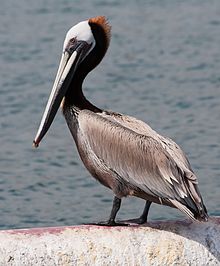
Pelicans, ibises, shoebills, egrets, herons, etc.
- Family Ardeidae - herons, egrets, and bitterns
- Genus Agamia – agami heron
- Genus Ardea
- Genus Ardeola – pond herons
- Genus Botaurus
- Genus Bubulcus – cattle egret (sometimes included in Ardea)
- Genus Butorides – green-backed herons (sometimes included in Ardea)
- Genus Cochlearius – boat-billed heron
- Genus Egretta
- Genus Gorsachius
- Genus Ixobrychus
- Genus Nyctanassa – American night herons
- Genus Nycticorax (sometimes includes Nyctanassa)
- Genus Pilherodius – capped heron
- Genus Syrigma – whistling heron
- Genus Tigriornis – white-crested tiger heron
- Genus Tigrisoma
- Genus Zebrilus – zigzag heron
- Genus Zonerodius – forest bittern
- Family Balaenicipitidae
- Genus Balaeniceps - shoebill
- Family Pelecanidae
- Genus Pelecanus - pelicans
- Family Scopidae
- Genus Scopus - hamerkop (sometimes included in Balaenicipitidae)
- Family Threskiornithidae - ibises and spoonbills
- Genus Bostrychia
- Genus Cercibis - sharp-tailed ibis
- Genus Eudocimus
- Genus Geronticus
- Genus Lophotibis - Madagascan ibis
- Genus Mesembrinibis - green ibis
- Genus Nipponia - crested ibis
- Genus Phimosus - bare-faced ibis
- Genus Platalea - spoonbills
- Genus Plegadis
- Genus Pseudibis
- Genus Thaumatibis - giant ibis
- Genus Theristicus
- Genus Threskiornis
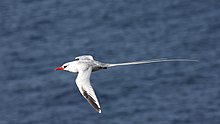
- Family Phaethontidae
- Genus Phaethon - tropicbirds

- Family Phoenicopteridae - flamingos
- Genus Phoeniconaias - lesser flamingo
- Genus Phoenicoparrus
- Genus Phoenicopterus

Woodpickers, flickers, toucans, aracaris, motmots, etc.
- Family Bucconidae – puffbirds, nunbirds, and nunlets
- Genus Bucco
- Genus Chelidoptera - swallow-winged puffbird
- Genus Hapaloptila - white-faced nunbird
- Genus Hypnelus
- Genus Malacoptila
- Genus Micromonacha - lanceolated monklet
- Genus Monasa
- Genus Nonnula
- Genus Notharchus
- Genus Nystalus
- Family Capitonidae – American barbets
- Family Galbulidae – jacamars
- Genus Brachygalba
- Genus Galbalcyrhynchus
- Genus Galbula
- Genus Jacamaralcyon - three-toed jacamar
- Genus Jacamerops - great jacamar
- Family Indicatoridae – honeyguides
- Genus Indicator
- Genus Melichneutes - lyre-tailed honeyguide
- Genus Melignomon
- Genus Prodotiscus - honeybirds
- Family Lybiidae – African barbets (recently split from Capitonidae)
- Genus Buccanodon - yellow-spotted barbet
- Genus Gymnobucco
- Genus Lybius
- Genus Pogoniulus - tinkerbirds
- Genus Stactolaema
- Genus Trachyphonus
- Genus Tricholaema
- Family Megalaimidae – Asian barbets (recently split from Capitonidae)
- Genus Caloramphus
- Genus Psilopogon
- Family Picidae – woodpeckers, piculets, and wrynecks
- Genus Blythipicus
- Genus Campephilus
- Genus Campethera
- Genus Celeus
- Genus Chloropicus
- Genus Chrysocolaptes – flamebacks
- Genus Chrysophlegma
- Genus Colaptes – flickers
- Genus Dendrocopos
- Genus Dendrocoptes
- Genus Dendropicos
- Genus Dinopium – flamebacks
- Genus Dryobates
- Genus Dryocopus
- Genus Gecinulus (placement in Megapicini tentative)
- Genus Geocolaptes – ground woodpeckers
- Genus Hemicircus
- Genus Jynx - wrynecks
- Genus Leiopicus – yellow-crowned woodpecker
- Genus Leuconotopicus
- Genus Meiglyptes
- Genus Melanerpes
- Genus Micropternus – rufous woodpecker (formerly in Celeus)
- Genus Mulleripicus
- Genus Nesoctites – Antillean piculet
- Genus Picoides
- Genus Piculus
- Genus Picumnus – American piculets
- Genus Picus
- Genus Reinwardtipicus - Orange-backed woodpecker
- Genus Sasia – Asian piculets
- Genus Sphyrapicus – sapsuckers
- Genus Veniliornis
- Genus Xiphidiopicus – Cuban green woodpecker (Placement in Dendropicini tentative)
- Genus Yungipicus
- Family Ramphastidae – toucans
- Genus Andigena - mountain toucans
- Genus Aulacorhynchus - green toucanet
- Genus Pteroglossus - aracaris
- Genus Ramphastos
- Genus Selenidera
- Family Semnornithidae – toucan-barbets (recently split from Capitonidae)
- Genus Semnornis

- Family Podicipedidae - grebes
- Genus Aechmophorus
- Genus Podicephorus - great grebe
- Genus Podiceps
- Genus Podilymbus
- Genus Poliocephalus
- Genus Rollandia
- Genus Tachybaptus
Petrels, storm petrels, albatrosses, and diving petrels
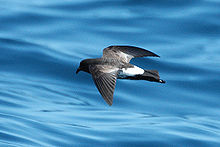
- Family Diomedeidae - albatrosses
- Genus Diomedea - great albatrosses
- Genus Phoebastria - North Pacific albatrosses
- Genus Phoebetria
- Genus Thalassarche - "mollymawks"
- Family Hydrobatidae - northern storm petrels
- Genus Hydrobates - European storm petrel
- Genus Oceanodroma
- Family Oceanitidae - southern storm petrels
- Genus Fregetta
- Genus Garrodia - grey-backed storm petrel
- Genus Nesofregetta - Polynesian storm petrel
- Genus Oceanites
- Genus Pelagodroma - white-faced storm petrel
- Family Procellariidae
- Genus Aphrodroma - Kerguelen petrel
- Genus Ardenna
- Genus Bulweria
- Genus Calonectris
- Genus Daption - Cape petrel
- Genus Fulmarus - fulmars
- Genus Halobaena - blue petrel
- Genus Macronectes - giant petrels
- Genus Pachyptila
- Genus Pagodroma - snow petrel
- Genus Pelecanoides - diving petrels
- Genus Procellaria
- Genus Pseudobulweria
- Genus Pterodroma - gadfly petrels
- Genus Puffinus
- Genus Thalassoica - Antarctic petrel
Parrots, parakeets, macaws, and cockatoos
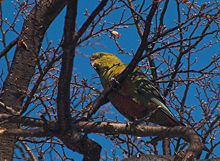
- Family Cacatuidae - cockatoos
- Genus Cacatua
- Genus Callocephalon - gang-gang cockatoo
- Genus Calyptorhynchus
- Genus Eolophus - galah
- Genus Lophochroa - Major Mitchell's cockatoo
- Genus Nymphicus - cockatiel
- Genus Probosciger - palm cockatoo
- Family Nestoridae - New Zealand parrots
- Genus Nestor
- Family Psittacidae - New World and African parrots
- Genus Alipiopsitta - yellow-faced parrot
- Genus Amazona - "Amazons"
- Genus Anodorhynchus
- Genus Ara
- Genus Aratinga
- Genus Bolborhynchus
- Genus Brotogeris
- Genus Conuropsis - Carolina parakeet
- Genus Coracopsis - Vasa parrot
- Genus Cyanoliseus - burrowing parrot
- Genus Cyanopsitta - Spix's macaw
- Genus Deroptyus – red-fan parrot
- Genus Diopsittaca - red-shouldered macaw
- Genus Enicognathus
- Genus Eupsittula
- Genus Forpus
- Genus Graydidascalus - short-tailed parrot
- Genus Guaruba - golden parakeet
- Genus Hapalopsittaca
- Genus Leptosittaca - golden-plumed parakeet
- Genus Myiopsitta
- Genus Nannopsittaca
- Genus Ognorhynchus - yellow-eared parrot
- Genus Orthopsittaca - red-bellied macaw
- Genus Pionites – caiques
- Genus Pionopsitta - pileated parrot
- Genus Pionus
- Genus Poicephalus
- Genus Primolius
- Genus Psilopsiagon
- Genus Psittacara
- Genus Psittacus – grey parrot and Timneh parrot
- Genus Pyrilia
- Genus Pyrrhura
- Genus Rhynchopsitta
- Genus Thectocercus - blue-crowned parakeet
- Genus Touit
- Genus Triclaria - blue-bellied parrot
- Family Psittaculidae - Old World parrots
- Genus Agapornis - lovebirds
- Genus Alisterus
- Genus Aprosmictus
- Genus Barnardius - Australian ringneck (sometimes included in Platycercus)
- Genus Bolbopsittacus - guaiabero
- Genus Chalcopsitta
- Genus Charmosyna
- Genus Cyanoramphus
- Genus Cyclopsitta
- Genus Eclectus
- Genus Eos
- Genus Eunymphicus
- Genus Geoffroyus
- Genus Glossopsitta - musk lorikeet
- Genus Lathamus - swift parrot
- Genus Loriculus - hanging parrot
- Genus Lorius
- Genus Melopsittacus - budgerigar
- Genus Micropsitta - pygmy parrot
- Genus Neophema
- Genus Neopsephotus - Bourke's parrot (sometimes included in Neophema)
- Genus Neopsittacus
- Genus Northiella - bluebonnet (often included in Psephotus)
- Genus Oreopsittacus - plum-faced lorikeet
- Genus Parvipsitta
- Genus Pezoporus
- Genus Phigys - collared lory
- Genus Platycercus - rosellas
- Genus Polytelis
- Genus Prioniturus - racket-tails
- Genus Prosopeia - shining parrot
- Genus Psephotellus
- Genus Psephotus - red-rumped parrot
- Genus Pseudeos
- Genus Psittacella - tiger parrot
- Genus Psittacula
- Genus Psittaculirostris
- Genus Psitteuteles (sometimes classified in the Trichoglossus)
- Genus Psittinus
- Genus Purpureicephalus - red-capped parrot
- Genus Tanygnathus
- Genus Trichoglossus
- Genus Vini
- Family Psittrichasiidae
- Genus Coracopsis - Vasa parrot
- Genus Psittrichas - Pesquet's parrot
- Family Strigopidae
- Genus Strigops - kākāpō

- Family Pteroclidae - sandgrouse
- Genus Calopterocles
- Genus Nyctiperdix
- Genus Pterocles
- Genus Syrrhaptes
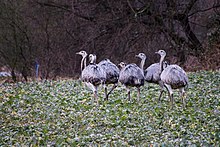
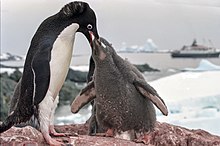
- Family Spheniscidae - penguins
- Genus Aptenodytes
- Genus Eudyptes - crested penguins
- Genus Eudyptula
- Genus Megadyptes
- Genus Pygoscelis
- Genus Spheniscus - banded penguins
Owls

- Family Strigidae - true owls
- Genus Aegolius – saw-whet owls
- Genus Asio – eared owls
- Genus Athene
- Genus Bubo – horned owls (paraphyletic with Nyctea, Ketupa, and Scotopelia)
- Genus Ciccaba
- Genus Glaucidium – pygmy owls
- Genus Jubula – maned owl
- Genus Lophostrix – crested owl
- Genus Margarobyas – bare-legged owl
- Genus Megascops – screech owls
- Genus Micrathene – elf owl
- Genus Nesasio – fearful owl
- Genus Ninox – Asian and Australasian hawk-owls and boobooks
- Genus Otus – scops owls (probably paraphyletic)
- Genus Pseudoscops – Jamaican owl
- Genus Psiloscops – flammulated owl
- Genus Ptilopsis – white-faced owl
- Genus Pulsatrix – spectacled owl
- Genus Pyrroglaux – Palau owl
- Genus Scotopelia - fishing owls
- Genus Strix – earless owls
- Genus Surnia – northern hawk-owl
- Genus Uroglaux – Papuan hawk-owl
- Genus Xenoglaux – long-whiskered owlet
- Family Tytonidae - barn owls
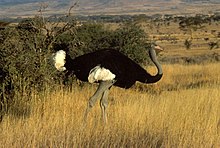
- Family Struthionidae - ostriches
- Genus Struthio
Boobies, gannets, frigatebirds, cormorants, shags, and darters

- Family Anhingidae
- Genus Anhinga - darters and anhinga
- Family Fregatidae
- Genus Fregata - frigatebirds
- Family Phalacrocoracidae
- Genus Phalacrocorax - cormorants and shags
- Family Sulidae

- Family Tinamidae - tinamous
- Genus Crypturellus
- Genus Eudromia
- Genus Nothocercus
- Genus Nothoprocta
- Genus Nothura
- Genus Rhynchotus
- Genus Taoniscus - dwarf tinamou
- Genus Tinamotis
- Genus Tinamus
Trogons and quetzals

- Family Trogonidae
- Genus Apalharpactes
- Genus Apaloderma
- Genus Euptilotis - eared quetzal
- Genus Harpactes
- Genus Pharomachrus
- Genus Priotelus
- Genus Trogon
 KSF
KSF